North Carolina War Between the States Sesquicentennial
At War: Battlegrounds and the Homefront
The following paragraphs help us today in our understanding of North Carolinians at war 1861-1865, and bring us
an appreciation of the devotion to hearth, family and State they demonstrated so amply. Not simply a chronological
order of events and naming of various regiments and battles, the presentation below gives us many examples
and glimpses of the unsurpassed valor of North Carolina's soldiers who defended their State.
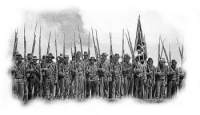
The Ranks Must be Filled:
"Old Thomas Carlton, of Burke county, was a good sample of the grand but unglorified class of men among us
who preserve the savor of good citizenship and ennoble humanity. He gave not only his goods to sustain
women and children, but gave all his sons, five in number, to the cause. One by one they fell, until at length a letter
arrived, telling that the youngest and last, the blue-eyed, fair-haired Benjamin of the hearth, had fallen also. When
made aware of his desolation, he made no complaint, uttered no exclamation of heart-broken despair, but called
his son-in-law, a delicate, feeble man, who had been discharged by the surgeons, and said, whilst his frail body
trembled with emotion and tears ran down his cheeks,
"Get your knapsack William, the ranks must be filled!"
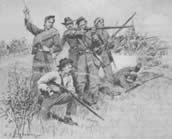
Bethel:
“This battle [Bethel]…was fought on the 10th of June, 1861. Being the first serious fight of the war…
Col. D.H. Hill had, with the First North Carolina regiment, thrown up an enclosed earthwork on the bank
of Marsh creek. The Confederate position was held by the following forces: Three companies of the Third Virginia,
under Lieut.-Col. W.D. Stuart…three companies of the Virginia battalion, under Maj. E.B. Montague;
five pieces of artillery, under Maj. (afterward secretary of war) G.W. Randolph, of the Richmond Howitzers;
and the First North Carolina, under Colonel Hill.
The companies composing the North Carolina regiment, which had the envied distinction of being the initial
troops to enter organized battle, were: Edgecombe Guards, Capt. J.L. Bridgers; Hornet’s Nest Riflemen (Mecklenburg),
Capt. L.S. Williams; Charlotte Grays, Capt. E.A. Ross; Orange Light Infantry, Capt. R.J. Ashe; Buncombe Rifles,
Capt. William McDowell; Lafayette Light Infantry (Cumberland), Capt. J.B. Starr; Burke Rifles, Capt. C.M. Avery;
Fayetteville Light Infantry, Capt. Wright Huske; Enfield Blues, Capt. D.B. Bell; Southern Stars (Lincoln), Capt. W.J. Hoke.
The whole force was nominally under the command of Col. J.B. Magruder, and numbered between 1,200 and 1,400 men.
(The Northern attack] was repelled mainly by [Major] Randolph’s accurate fire, aided by the gallant conduct of the
Burke Rifles under Captain Avery and by the Hornet’s Nest Rifles. A little late in the action the Edgecombe Guards,
Captain Bridgers, gallantly retook a redoubt that had, on the accidental disabling of a gun, been abandoned by
the Confederates. In front of this redoubt the Federals had found shelter behind and in a house.
Colonel Hill called for volunteers from the Edgecombe guards to burn this house. Sergt. George H. Williams,
Thomas Fallon, John H. Thorpe, H.L. Wyatt, and R.H. Bradley promptly offered their services and made a brave
rush for the house. On the way a shot from the enemy’s rear guard struck Wyatt down. The determined spirit of
this heroic young soldier led to a premature death, but by dying he won the undying fame of being the first
Confederate soldier killed in action.
An attempt to turn the Confederate left having failed, [the Northern] forces retreated toward Fortress Monroe.
The Confederate loss in this precursor of many bloody fields was 1 killed and 11 wounded; the Federal loss was
18 killed and 53 wounded. In the South this little victory over a vastly superior force awakened the wildest enthusiasm,
for it was thought to indicate the future and final success of the cause for which its people were battling.”
(Confederate Military History, D.H. Hill, Jr., pp. 17-20)
Fleeting Moments of Loving Ministry:
“In 1861, Greensboro was a peaceful hamlet of about 2,000 souls, but when the tocsin of war sounded
at Sumter, the Revolutionary blood in the veins of our people leaped into instant action. In the dark time
of infinite endurance that followed, the women suffered and shared the fears and hopes of the impending battles,
the harrowing days, the hopeless nights, the dread to-morrows.
The noble army of the Red Cross had not then unfurled its banner to the world, and the unspeakable blessing
of hospitals and trained nurses was as yet unknown. More pitiful was the lack of anesthetics. Yet in this
painful lack of equipment, the self-sacrifice, the ingenuity, and faithful service of our women made what
amends were possible.
A central room was established where quilting and sewing were daily and diligently done. Every piece of old
linen was scraped and cherished, bandages made, carpets taken up; and all blankets, clothing, food, and
whatever could be given up for the comfort of the boys were sent to the camps. A little amateur band of canteen
workers met the trains bearing the wounded, often in the darkness of night, with such refreshments as they could
provide for the weary men, and in these fleeting moments of loving ministry precious items of news from home
and camp and friends were eagerly sought and given ere the train sped on.
Weary, footsore, and needy soldiers were daily passing through to be clothed, fed, and comforted; and
whenever the Danville train came in with grey-coats on board, it was a signal to broil bacon, bake cornbread,
and set out all the milk one could lay their hands on – the only delicacies we could then afford.
In this labor of love all our hearts were sore with suspense and foreboding for husbands, sons, and brothers
on the firing line, not knowing what a day or even an hour might bring forth; and many homes were darkened
as the casualties fell pitilessly here and there.”
(The Women of the South in War Times, pp. 230-231)
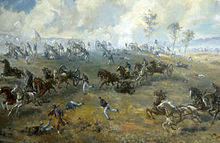
First Manassas:
"The six weeks that intervened between Bethel and First Manassas were weeks of ceaseless activity.
Regiments marched and countermarched; North Carolina was hardly more than one big camp, quivering with
excitement, bustling with energy, overflowing with patriotic ardor. The Confederate army under Generals Johnston
and Beauregard was throwing itself into positon to stop the "On to Richmond" march of the Federal army under
General Irvin McDowell. In this great battle, so signally victorious for the Confederate arms, North Carolina had fewer
troops engaged than it had in any other important battle of the armies in Virginia.
Col. W.W. Kirkland's Eleventh (afterward Twenty-first) regiment, with two companies -- Captain Conolly's
and Captain Wharton's -- atttached, and the Fifth, Lieut.-Col. J.P. jones in command during the sickness of
Colonel McRae, were present, but so situated that they took no part in the engagement.
The Sixth [North Carolina] was hotly engaged, however, and lost its gallant colonel, Charles F. Fisher
[Fort Fisher on the Cape Fear would be named for him]. When this regiment arrived at Manassas Junction,
the battle was already raging. Colonel Fisher moved his regiment forward entirely under cover until he reached
an open field leading up to the famous Henry house plateau, Fisher's presence was not even suspected by the
enemy until he broke cover...and with commendable gallantry, but with lamentable inexperience, cried out to his
regiment, which was then moving by flank and not in line of battle, "Follow me," and moved directly toward the
[enemy artillery] guns.
At this juncture Capt. I.E. Avery said to his courageous colonel, who was also his close
friend, "Now we ought to charge." "That is right captain," answered Fisher, and his loud command,
"Charge!" was the last word his loved regiment heard from his lips. In prompt obedience the seven
companies rushed up to the guns, whose officers fought them until their men were nearly all cut down
and their commander seriously wounded. But the charge was a costly one. Colonel Fisher, in the words
of General Beauregard, "fell after soldierly behavior at the head of his regiment with ranks greatly thinned."
With him went down many North Carolinians "whose names were not so prominent,
but whose conduct was as heroic."
One of the companies composing the Sixth came from Rowan county, and Colonel Fisher himself had long
been a conspicuous citizen of Salisbury. From 1851 Fisher had been convinced that secession was inevitable,
and after the election of Lincoln he had begun the organization of a volunteer regiment among the young men in
the western part of the State, particularly in the counties adjacent to the North Carolina Railroad. The Sixth Regiment,
equipped from Fisher's private purse, left its training camp in North Carolina on July 10, and had been at the "front"
barely ten days when fate assigned its commander a rendezvous with death. Charles Frederick Fisher was an eminent
figure in State politics during the first half of the century, and had been editor of the Western Carolinian at Salisbury
and in 1855 had succeeded John M. Morehead as president of the North Carolina Railroad.
The Sixth lost 73 men in killed and wounded. This battle ended the fighting in Virginia for that year [1861].
North Carolina, however, was not so fortunate, for the next month saw [Northern forces descend] upon its coast."
(Confederate Military History, D.H. Hill, Jr., pp. 21-23)
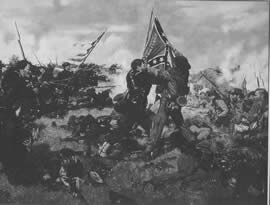
Mrs. Armand DeRossett: The Soldier's Angel of Mercy:
"The North Carolina coast was especially inviting to the attacks of the enemy, and Mrs. DeRosset’s
household was removed to the interior of the State. Her beautiful home in Wilmington was despoiled largely
of its belongings; servants and children were taken away, but she soon returned to Wilmington...and she devoted
herself to the work of helping and comforting the soldiers.
Six of her own sons and three sons-in-law wore the grey. The first work was to make clothing for the men.
Many a poor fellow was soon without a change of clothing. Large supplies were made and kept on hand.
Haversacks were home-made. Canteens were covered. Cartridges for rifles, and powder bags for the great
Columbiads were made by hundreds. Canvas bags to be filled with sand and used on the fortifications, were
largely used at Fort Fisher – and much more was in requisition.
The ladies would daily gather at the City Hall and ply their busy needles or machines, with never a sigh of weariness.
When troops were being massed in Virginia, Wilmington, being the principal port of entry for the Confederacy,
was naturally an advantageous point for obtaining supplies through the blockade, and Mrs. DeRosset, ever watching
the opportunity to secure them, had a large room in her dwelling fitted up as a store room. Many a veteran in these
intervening years has blessed the memory of Mrs. DeRosset and her faithful [aides] for the comfort and refreshment
so lavishly bestowed upon him. Feasts without price were constantly spread at the depot. Nor were their spiritual
needs neglected. Bibles, prayer books and hymn books were distributed.
Men still live [1895] who treasure their war Bible among their most valued possessions."
(Confederate Veteran, July, 1895, pp. 218-219)
Fighting Along the Coast:
"On its secession the State undertook the protection of its long coast line by the erection of forts at [the]
inlets and by the establishment of a fleet of small vessels fitted by their shallow draft to defend the waters
of the sounds. To lighten the load of the governor in this time of intense activity, the legislature, not profitting
by the failure of the Board of War during the Revolution, created a similar body known as the Military and Naval Board.
This Board, consisting of Warren Winslow, Military Secretary, and Chairman, James A.J. Bradford, and
Haywood W. Guion, took over most of the military activities of the State, including the coast defenses.
Under the direction of the Board two departments of coast defenses were established. The northern, extending from
Norfolk to New River in Onslow County, was put under the command of Brigadier-General Walter Gwynn; the
southern comprising the sea front from New River to South Carolina, was committed to Brigadier-General Theophilus
H. Holmes, who had recently resigned his commission as major in the United States Army and offered his
services to North Carolina, his native State. THese two officers, both of course acting at that time only
under State commissions, entered on their duties on May 27, 1861.
Just a month later, however, all the forts in process of building, together with those already existing, namely,
Fort Caswell and Fort Johnston near Wilmington, and Fort Macon at Beaufort Inlet, were ceded to the
Confederate government, but the transfer of property and troops was not completed until about the middle of August.
Forts were built at Hatteras, six miles from the stormy cape; at Oregon Inlet just south of Roanoke Island;
at Ocracoke Inlet, about thirty miles below Hatteras Inlet; and the formidable Fort Fisher, near Wilmington,
was begun. The three forts already existing -- Fort Macon, guarding the harbor of Beaufort, and Forts Caswell
and Johnston protecting Wilmington, were strengthened, but could not be either adequately armed or fully manned.
An attempt to have the State man its own seaboard fortifications was made shortly after North Carolina
withdrew from the Union. R.H. Smith, of Halifax County, introduced in the convention on May 28 an ordinance
to raise seven regiments of troops to be used exclusively for coastal protection. [Governor John W. Ellis] said:
"If the batteries are properly served, a fact of which I could entertain no doubt, the power of the
United States navy is not sufficient to effect an entrance into any one of these forts."
(Bethel to Sharpsburg, pp. 155-157)
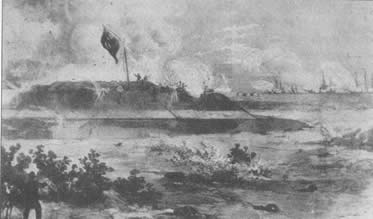
From Roanoke Island to New Bern:
“Roanoke island, said the Raleigh Standard in October [1861], “is an important strategic point for the protection
of the region bordering upon Albemarle Sound, and to check any rear movement of the enemy against Norfolk.
It is, therefore, of great importance that the eyes of President [Jefferson] Davis and Governor [Henry Toole] Clark
should be directed to that point. The intimations from the North are strong that the enemy will soon attempt to
assail Roanoke island with a strong force from Hatteras.”
Early in January came reports that a fleet with many transports had sailed for Hatteras….[and] the New York Times
thought it was a matter of easy conjecture that its objective was the North Carolina forts on the Pamlico and
Albemarle sounds. The troops and the defensive equipment supplied to the forts at Roanoke island and at New Bern
were no match for the 15,000 Northern soldiers and the heavy ordnance carried on their gunboats. The defenders
comprised about 1435 men of the Eighth and Thirty-first North Carolina Regiments, assisted by the Forty-fifth
and Fifty-ninth Virginia Regiments. On the North Carolinians breastworks were smooth-bore cannon little superior
to the type used in the Revolution against the British. One regiment was armed with squirrel rifles and shotguns
and the best trained of North Carolina troops were in Virginia.
The battle of Roanoke island began on February 7, 1862. The small North Carolina fleet, commanded by
William F. Lynch, after using up all its ammunition had to retire. Northern troops were landed and the defenders were
compelled to surrender. In a few days the Northern fleet and troops raided as far as Elizabeth City, Edenton and
Winton, they burned the latter.
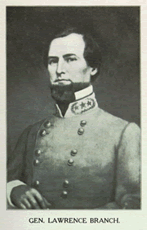
The next point of attack was New Bern, where General L. O’B. Branch [of Enfield, North Carolina] had less than
5,000 men against the formidable array of Northern ships and soldiers. The battle of New Bern was fought on March 14,
and despite the valor displayed by Col. Zeb Vance’s Twenty-sixth North Carolina Regiment and one or two other
units, Gen. O’B. Branch ordered a retreat to Kinston. New Bern was left to its fate.
No one but Negroes and “poor whites” were around to greet the victors. The Negroes, “hilarious in the employment
of their newly found “Uncle Sam,” were holding “a grand jubilee.” While some “in their rude way” thanked God
for their deliverance, others danced in “wild delight” and sang, and still others, “with an eye to their main chance,”
were pillaging the stores and dwellings.
The Northern soldiers and sailors soon joined the Negroes in these acts of lawlessness, and for a day or two after
its capture, New Bern was pillaged with no restraint. Northern General Burnside selected a stately old home in
New Bern for his headquarters, but when an aide went to get the home in order, he found it in the process of being
plundered by soldiers, sailors, and Negroes. One old Negro was trying his best to make off with all the china ware.
Only the threat of putting the vandals in irons got them out of the house.
The people of North Carolina were shocked and angry at the apparently easy conquest of New Bern. [And] as a
result of these successive defeats, North Carolina people, declared Gen. D.H. Hill, “saw plainly that the Richmond
authorities had been far too slow in realizing the State’s condition and the importance of the territory being lost.”
The effect, however, was to stimulate new exertions for home defense, and within a short time fifteen
regiments had been organized.”
(North Carolina, The Old North State and the New, Vol. II, pp. 230-231)
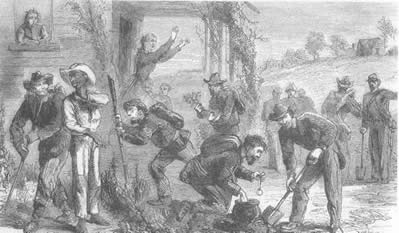
The Pillage of New Bern:
“For a day or two after its capture the town with its neighboring country was pillaged without restraint.
“The soldiers and sailors had free run in New Bern the first twenty-four hours,” writes Putnam,
a member of the Twenty-fifth Massachusetts Regiment. Everything that the soldiers wanted and much
that they did not want was taken from the defenseless homes. During the remaining years of the war the
Federal pillaging of Eastern North Carolina was so unrestrained and so shameless that a writer of this
generation has no heart to recount its sickening details.
Captain Thomas H. Parker of the Fifty-first Pennsylvania Regiment [wrote]: “All the large plantations
throughout the South have vaults or graveyards close to the mansion…a vault on this place, close to
the dwelling house and within 50 yards of the Trent river, contained a large number of coffins with remains
of members of the family for several generations back, but a visit to the place by members of a Connecticut
and a New York regiment, soon reduced the structure to a shapeless collection of ruins, having
burst the cerements of the departed and piled the bones in a confused mass…All the property in this
region was abandoned…and the places left to the ruthless mercy of the Yankee army…”
(Bethel to Sharpsburg, pp. 235-237)
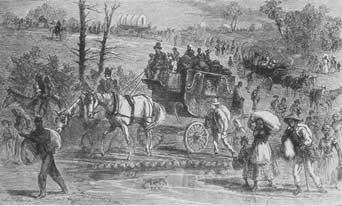
Refugeeing in North Carolina:
The port city of Wilmington, guarded by Fort Fisher until early 1865, was a refugee center.
Those in search of commercial opportunities, employment, or passage to a foreign country flocked to the city,
but never were hundreds banished from Northern lines dumped on the city at one time as in the case of Charleston,
Savannah and Mobile. Refugees came from all areas of the Confederacy -- James Ryder Randall was surprised to find
several New Orleans families living in his boardinghouse. These, he said, "were birds of passage" who hoped to
get to Nassau. Although Wilmington was crowded throughout the war, hundreds of people in flight before Sherman
arrived in its last months. A local citizen referred to this last influx as "the most serious difficulty we have had to
contend with," and she estimated that "thousands...[representing] all classes and grades...[came] from all directions,"
and were being "put in every nook and corner" of the city. Although many Wilmington citizens moved to the
interior of the State, the greatest single evacuation was not the enemy but the yellow fever epidemic [of Fall, 1862]."
(Refugee Life in the Confederacy, page 78)
The Peninsular Campaign:
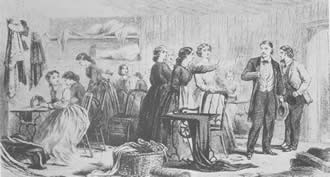
Caldwell County’s “Little Rebel”:
“For all the hardships on the home front, support for the war was still strong enough in the
spring of 1862 to allow the original companies raised in Caldwell to easily refill their ranks. Avoidance
of the stigma of being drafted and the desire to bond with friends and relatives who had been the first
to enlist played a major role in drawing older men into the army.
But at least as important was the fear of being seen as an effeminate coward by the young women,
nearly all of whom were impassioned Confederates. In addition to sewing and weaving clothes for the
troops and sending off packages of food, household items, and bandages, young women served as
the Confederate army’s most effective recruiters.
Laura Norwood, [Walter Lenoir’s] twenty-one year niece, took pride in referring to herself as a “little rebel.”
She was among the young women who presented a company flag to the Caldwell Rough and Readys
when they left Lenoir for the war. Writing Walter in April 1862, she assured him that “never will I be defeated,
never, under the Sun!” For her and countless other young women, the war was a heroic adventure in which
the “generous, the brave, the self-denying, self-forgetting, the fearless, the true-hearted, the daring, the
unyielding to temptation, in a word the True!” risked all in the defense of country and loved ones. She need
hardly have added that no coward could ever claim her love.
[Other Southern women] found reason enough to steel themselves when the read or heard of
Yankee atrocities committed on Southern soil. Unlike Laura, Walter’s sister Sarah was a reluctant
Confederate at the onset of what she called this “cruel war.” But her nephew Nathan Gwynn, home
recuperating from a wound in the winter of 1862, convinced her of the need to endure whatever sacrifices
were called for. “It makes my heart ache and my blood boil to hear Nathan tell about those Yankees!”
she wrote Walter. “I could not believe the newspapers! But I have to believe him! Surely our army would
not do so, in the Northern States. They would not harm the women and children and destroy the churches.!”
(The Making of a Confederate, pp. 69-70)
Methodist Clergyman Joel W. Tucker of Fayetteville:
"In quick succession he gave three sermons that were published and distributed throughout the South as
comforting, if stern, theological interpretations of the place of the Confederacy in divine history. In one of
the sermons, "God's Providence in War," delivered to his congregation in Fayetteville on Friday, 16 May 1862,
a general fast day, Tucker saw the ongoing war as "a conflict of truth with error -- of the Bible with
Northern infidelity -- of pure Christianity with Northern fanaticism -- of liberty with despotism -- of right with might."
In the next, "God Sovereign and Man Free" (1862), he prayed "for the success of our cause; for the triumph
of our armies," arguing that God could "answer our petitions, because he has sovereign control over of the
bodies and souls of men." These two sermons expressed succinctly and clearly the epitome of Southern
wartime religious ideology, making Tucker momentarily one of the most popular and lauded
prophets of the wartime South.
The third published sermon, "Guilt and Punishment of Extortion," preached on 7 September 1862, was
directed at the extortioners who caused serious price inflation and contributed to the scarcity of certain goods.
(Dictionary of North Carolina Biography, Vol. 6, page 58)
The Struggle for Richmond, 1862:
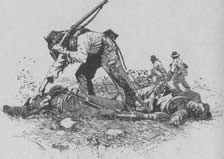
After the Seven Days Battle:
“In late June [1862], Walter [Lenoir] took a break from his camp duties and went to Richmond to confer
with [Zebulon] Vance on the disposition of the men in his Caldwell [county] company. There he had a chance
to walk over the sites of the Seven Days Battles, where thousands of Confederate troops had successfully
defended Richmond against General George B. McClellan’s massive Union army. The signs of combat
were still fresh and raw when Walter visited on June 30, picking up spent bullets, Yankee cartridges,
and other battlefield detritus as souvenirs for [his brother] Rufus.
He was struck by the incongruity of seeing so many dead and dying soldiers covering placid
farm fields: “To the eye they were fields with the fences down, and crops less interfered with than you
would have supposed, and fresh graves and dead men & horses lying in the sun here and there, all over them.”
When he returned a few days later to sites he had already visited, he observed that many of the Yankee
dead were still unburied. One poor soul, a wounded Yankee whom Walter had seen on Monday,
was still there on Friday, “dying but not yet dead.” By then, the Confederate dead had found
a resting place in shallow graves dug where they fell, their names inscribed on crude pieces of
planking placed at the head of their graves.
Unless the bodies were removed to a new burial site and more permanent markings erected,
the identity of the fallen would be forever lost, he mused. “They fell fighting as heroes and patriots fight,”
he wrote Rufus, “and they will be remembered and thought of with love & regret at home, long after
their memory would have been forgotten if they had lived in inglorious ease at home."
(The Making of a Confederate, Walter Lenoir, pp. 72-73
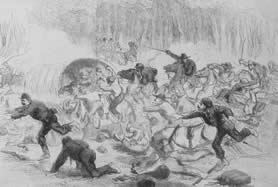
Second Manassas:
“North Carolina had eleven regiments and one battalion of infantry and two batteries of artillery engaged…
In [General Evander] Law’s brigade was the Sixth regiment, Major R.F. Webb; in [General Isaac] Trimble’s, the
Twenty-first and First battalion; in [General Laurence O’B.] Branch’s brigade, the Seventh, Captain R.B. MacRae;
the Eighteenth, Lt. Colonel Purdie; the Twenty-eighth, Colonel J.H. Lane; the Thirty-third, Lt. Colonel R.F. Hoke, and
the Thirty-seventh, Lt. Colonel W.M. Barbour; In [General William D.] Pender’s brigade, the Sixteenth,
Captain L.W. Stowe; the Twenty-second, Major C.C. Cole; the Thirty-fourth, Colonel R.H. Riddick, and the
Thirty-eighth, Captain McLaughlin; Latham’s battery, Lt. J.R. Potts, and Reilly’s battery, Captain James Reilly.
On the morning of the 30th [July, the Northern commander] massed [his troops] in a final effort to crush
[General Stonewall] Jackson. Straightaway…Reilly’s North Carolina battery…opened a destructive enfilade
fire on Jackson’s assailants. “It was a fire that no troops could live under for ten minutes,” is [General James]
Longstreet’s characterization of the work done by these batteries, soon added to by all of Col. [Stephen Dill] Lee’s guns.
The Federal lines crumbled into disorder from the double fire, but again and again they stoutly reformed, only at
last to be discomfited. For the possession of the Henry house hill, so vital to the Federal retreat, both sides fiercely
contested, and the dead lay thick on its sides. General Law reports that he united the Sixth North Carolina with his
other regiments in a charge on a destructive battery near the Dugan house, and drove the gunners from it.
Latham’s and Reilly’s batteries contributed their full share to this victory. Col. R.H. Riddick, whose power as a
disciplinarian and ability as a field officer had made the Thirty-fourth North Carolina so efficient, was mortally
wounded there, as was Major Eli H. Miller, and Captain Stowe, commanding the Sixteenth North Carolina. The
North Carolina losses in the two days and one night at Manassas were as follows: killed, 70; wounded 448.
At Ox Hill, or Chantilly, they were: killed, 29; wounded, 139.”
(Confederate Military History, pp. 99-104)
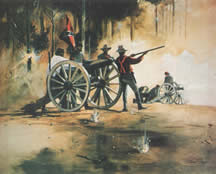
Captain Walter Lenoir at Cedar Mountain and Ox Hill:
“[On July 23, [1862] Walter W. Lenoir of Caldwell county learned] he had been elected and appointed first
Lieutenant of Company A in the 37th North Carolina regiment. On the way to Richmond, Walter learned that
the captain of Company A had resigned on account of bad health, and he had been promoted to take the
captain’s place. The news left him with a heavy sense of responsibility, for he was now asked to command
battle-hardened veterans.
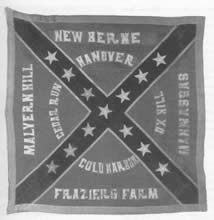
Walter’s regiment had been in camp near Gordonsville [Virginia] for only a few days when it received
marching orders on August 6. [Despite stomach problems]…he found himself relishing the nightly fare
of dry army crackers, cakes of flour heated on strips of wood over an open fire, badly cooked beef
roasted on sticks, and raw bacon.
After a few days he and his men were filthy and covered with body lice, an indignity Walter blamed
on the abandoned Yankee knapsacks they found on the outskirts of Richmond. Since learning that
he would be serving in General Thomas “Stonewall” Jackson’s corps, Walter had always expected
to be sent “to some place where there is good work to be done.” That place was Cedar Mountain.
Walter’s company had about an hour to rest before it was thrown into the battle to fill the gap in the
Confederate lines. The thought of dying, but not of being wounded, ran through his mind. Most of his men,
he observed, became serious as they awaited battle, yet once in action they seemed to possess an
amazing ability to cast aside their fear of death and face with cool indifference the awful sights and
sounds that would envelop them.
The battle enveloped Walter in a bedlam of noise and confusion as the retreating Virginians swarmed
through the Confederate lines, separating him from some of the men in his company …[but able to keep]
the remnant of his company moving forward only by constant effort. After repulsing a Union cavalry charge
(“in almost an instant eight or ten dead horses were piled in the road”), the Confederates charged…
across the cornfield to attack the fleeing Yankees, but they quickly fell back to a safe position.
After praising his men for their bravery and checking on casualties and those present for duty,
Walter joined other Confederates in roaming over the battlefield. The Yankees had been badly bloodied;
Walter stepped over the bodies of at least six or eight of their dead. Yet no one had been killed
or wounded in Walter’s company and casualties in his regiment were very light. He could find no
explanation for the contrast “except that our God in whom we trust favored our righteous cause.”
[Resting on a slight ridge after the Ox Hill engagement of August 31, Walter] felt an “awful pain” in his right leg.
A minie ball had ripped through it about halfway between his knee and foot, smashing both bones. No
sooner had he told [Captain] Morris that he thought his leg had been broken when a second ball, perhaps
skipping up from the ground, laid bare the shinbone in the same leg and took off his right toe.
Disabled and fearing that he would bleed to death from a severed artery, he began to drag himself toward
the rear…[and] Exhausted after crawling for about fifteen feet, he collapsed in a small clearing by the road.
As sand was thrown into his face by minie balls striking the ground near his head and Yankee artillery
shells exploded all around him, he realized he was in a more exposed position than the fence he had just left.
He lay hopeless, waiting to die.
Looking back, Walter marveled at how calm and resigned he had felt. What sustained him was faith
in the God he never had acknowledged in a public confession of faith. He felt that he was “in the hands
of a good and merciful God and that He would do with me what was right.”
(The Making of a Confederate, pp. 77-88)
Sharpsburg:
“On Tuesday, September 16 [1862], the prelude to the main battle at Sharpsburg began.
General McClellan had pushed the remained of [General Robert E.] Lee’s army through the gaps of
South Mountain to a point near Antietam Creek, where he hoped to trap and destroy the Confederates.
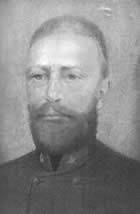
Major James T. Reilly
The Rowan Artillery [of Major James T. Reilly] joined the action at ten o’clock. Two sections of rifled guns,
composed of two three-inch rifles commanded by Lieutenant [Jesse] F. Woodard [of Wayne county]
and two ten-pound Parrott rifles commanded by Lieutenant [John A.] Ramsay [of Iredell county], received
orders to engage the enemy and maintain a steady well-directed fire until ordered to redeploy. After
expending four hundred and eighty-four rounds of ammunition and with two horses killed and one
wounded and abandoned, the battery was ordered to retire to the rear,
refill their ammunition chests and encamp.
Early in the morning, the battery’s two rifled sections proceeded with the rest of Major
[Bushrod Washington] Frobel’s Battalion to oppose the Union advance from the cornfield and around
the Dunkard Church. Reilly’s Battery fired into the enemy with devastation effect until their ammunition
was exhausted…During [the Antietam Creek bridge] assault, the howitzer section of the
Rowan Artillery suffered greatly from [Northern] massed artillery fire. All their horses were killed and they
had to draw theirguns back to safety to avoid capture. One gun was totally disabled; three men were killed,
two wounded and two missing.
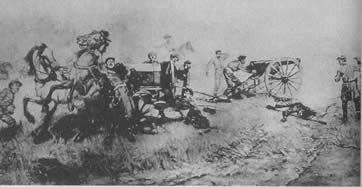
More than five hundred cannons participated in the battle, firing over fifty thousand rounds of ammunition.
The cannonading was so intense that Confederate artillery commander, Colonel S.D. Lee, called it “artillery hell.”
The psychological effects and confusion were overwhelming. Extreme noise levels of the guns, exploding
of case and shot overhead and the agonizing screams of men being wounded and killed were deafening.
The odor of fresh flesh being torn from bodies and the putrid smell of flesh left to rot assaulted the senses.
Horrible sights and sounds included horses killed and wounded, struggling to escape without legs and
eyes as large as saucers from fear and panic.
General A.P. Hill’s arrival from Harper’s Ferry saved the Army of Northern Virginia in a nick of time.
Hill smashed into [the Northern] left flank, driving [them] back. This day, September 17, 1862, was
the bloodiest single day in American history with a total of twenty-three thousand men killed or wounded.
The day after the Battle of Sharpsburg the men of Reilly’s Battery were commanded to “trot march,” but
did not obey. The men and horses were “give out,” having been on the field of battle four days, the last
two and a half without rations.”
(Men of God, Angels of Death” pp. 54-57)
Battles in North Carolina:
Garrison Life on the Coast:
"It is difficult to imagine what life must have been like for the four hundred to eight hundred Confederate soldiers
[mostly North Carolinans] who were garrisoned at Fort Caswell during this war. Letters written to friends and
family memebrs bring the Twentieth Century viewer closer to their experiences and feelings than any other medium.
Letters Home:
"We have to cook for ourselves...You would laugh if you could be here about eating time, and see th soldiers
scrambling for something to eat. We have plenty to eat though you must know it is badly cooked."
(Lily, April 17, 1861)
"The weather is "absolutely hot. Hot enough to cook eggs if we had any of that article down here."
The soldiers speend the rest of their days lounging "about in the shade when we can find anything like
a shade (tree), there is no trees you must recolect (sic) and when night comes instead of getting cooler it
positively gets warmer and the mosquitoes come in swarms...Some of them (are) as large as humming birds
with bills half an inch long. So that with the heat and the mosquitoes there is no such thing as sleeping."
(McNeil, August 18, 1862).
Christmas, 1862 -- "We had turnips, Beef and Bacon for dinner which was good enough for supper. Oyster
soup which was better." (McNeil, January 4, 1863)
"Please send the following articles -- 1 or 2 hams (one boiled, the other raw) as much sausage as you can
spare, two or three bottles of catsup, as much butter as you can get well salted, two or three heads of cabbage,
some biscuit as many as you want to cook for those you cooked for me before I left home are better today
than the bread cooked here. Please send a bill of the things giving the market rates at home; for I must make
a report at the end of the month to the mess and will get pay or something else to eat in return for it."
(Turrentine, February 2, 1863)
Christmas 1863 -- "My mess had a very fine dinner -- for a sample, we had chicken, turkey, spunge (sic)
cakepound cake and a great many other kinds of cakes." (Duie, December 27, 1863)
(Fort Caswell in War and Peace, pp. 34-36)
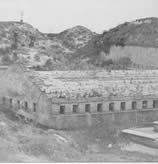
Postwar Fort Caswell
Lincoln's Proconsul in Occupied New Bern:
"It was Lincoln's policy to "restore" disaffected States or parts of States to the [Northern] Union whenever
possible. In April, 1862, secretary of war Stanton announced the appointment of [North Carolina native]
Edward Stanly as military governor of North Carolina. He was a Whig, devoted to the Union, and on going
to California about 1856 had affilliated himself with the Republican party of that State.
He was quick to comprehend the difficulty in reconciling the population to the Lincoln administration. From
New Bern on June 12, in a letter to Secretary Stanton, he said..."Unless I can give them some assurance
that this is a war of restoration, and not of abolition and destruction, no peace can be restored here for
many years to come." Protesting against...the "shameless pillaging and robbery" which he had witnessed,
Stanly resigned early the following year."
(The Old North State and the New, page 243)
Catherine Edmondston's Reaction to the Appointed Governor:
June 12, 1862:
"Stanly, the renegade, the traitor governor, appointed by Mr. Lincoln to rule his native State, finds
the way of the transgressor hard. He has stopped the Negro schools as being contrary to the
Statute Law of North Carolina, by which he has offended his Northern masters, but with a strange
inconsistency he ignores the fact (of which Mr. (George Edmund) Badger has reminded him however)
that his being here, as Gov, is as much an infringement on our rights, for the Laws of N.C. provide
for an election of the Gov by the people.
He said that if there was one man in N.C. whom he regarded more than another,
one man whom he loved, that man was Richard S. Donnell, & yet the first sight which greeted him on
stepping ashore at New Berne was the coffin of Mr. Donnell's mother with her name & the date of her
birth & death cut on it, waiting shipment to NY, her remains having been thrown out to give place
to the body of a Yankee officer! Such is our foe."
June 22, 1862:
"We hear that Lincoln has recalled Stanly from the governorship of North Carolina. How true it is that it
is hard to serve two masters! The shallow artifice by which he attempted to throw dust in our eyes by
professing to govern us by the Statute Laws of N.C. displeased his Northern masters, whilst his
being here at all is such an infringement of our rights that no plausibility could even gild the pill.
Richard Dobbs Speight, Gov of NC, was killed in a duel by Edward Stanly's father many years ago.
His grave was violated by the Yankees when they had possession of New Berne, and his skull stuck
upon a pole was one of the first objects which met Stanly's eyes as he landed in New Berne
as Lincoln's governor, appointed to subjugate his native State."
(Journal of A Secesh Lady, pp. 193-200)
Lincoln's Proconsul Condemns Pillage:
“In a letter to Senator Charles Sumner of Massachusetts, [Edward Stanly] describes the vandalism
of the [Northern] army on its various expeditions:
Had the war in North Carolina been conducted by soldiers
who were Christians and gentlemen, the State would long ago have rebelled against the rebellion. But,
instead of that, what was done? Thousands and thousands of dollars worth of property were conveyed North.

Libraries, pianos, carpets, mirrors, family portraits, everything in short that could be removed was stolen
by men abusing flagitious slaveholders and preaching liberty, justice and civilization. I was informed that
one regiment of abolitionists had conveyed North more that 40,000 dollars worth of property. They literally
robbed the cradle and the grave. Cases were numerous where old men were thrown into prison after the
horses and barns were destroyed by fire they were robbed. I remember one instance where several houses
were burned and robbed, and among others that of a Methodist preacher, whose
Bible, library and only horse were stolen.”
(Bethel to Sharpsburg, pp 237-238)
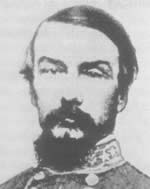
Appeal to Southern Patriotism at Wilmington:
“During a dress parade [at Camp Davis, near Wilmington] on the evening of May, 31 [1862],
[Col. Collett Leventhorpe] read the infamous “Woman’s Order” (General Orders No. 28), issued by the
Union commander of occupied New Orleans, Maj. Gen. Benjamin “Beast” Butler, in response to various indignities –
spitting, curses, hateful glances, etc. – heaped upon the Yankee soldiers there. Leventhorpe told his troops
[of the 11th, 43rd and 51st North Carolina Regiments]:
“Fellow soldiers: The infamous order which you have just heard, proceeds from the General, whom fortune
of war has placed in possession of one of the noblest cities of the South. The base enemy we oppose, not
content with crimes of invasion, with insurrectionary attempts among our domestic population, and with pillaging
the fairest regions of our country, has now openly dared the threaten our most sacred relations, and to place
our wives and daughters upon the footing of common prostitutes of the town.
Gentlemen of North Carolina, the debased passions of soldiery need no such incentive. The records of crime
written in the sad annals of Maryland, and in those other unfortunate portions of our country which have been
polluted by the enemy’s feet, prove but too well the fate, worse than death, which awaits those most dear
to us in the event of his conquest and our humiliation.
But, fellow soldiers, with the blessing of god, we need fear no such destiny for our country.
Relying then on that blessing, let us resolve as one man that Wilmington shall not be reached by the invader,
and, in the hour or trial, recalling these scandalous threats against our wives and daughters of New Orleans,
let us meet him sternly and hurl him back upon his beats at the point of a bayonet.”
(Collett Leventhorpe, the English Confederate, pp. 70-71)
Plymouth:
Chancellorsville:
The Gettysburg Campaign -- The First Day
Colorbearers of the 13th North Carolina
By 4PM the Federal forces had retreated to Seminary Ridge, where they formed a hastily constructed line
with breastworks of rails and dirt on the slope fronting the west of the Ridge. The Confederate Brigades of
Brig. Gen. James Lane, Brig. Gen A.M. Scales, and Colonel Abner Perrin, in Maj. Gen Dorsey Pender’s
division of Hill’s corps, charged across an open field and then up the slope, encountering a storm of shot
and shell from the batteries and the musketry of the infantry.
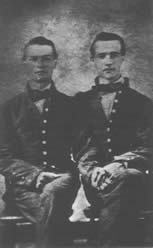
Levi & Henry Walker,
13th North Carolina Regiment
In many cases the colors of the regiments were advanced several paces in front of the line.
Despite taking severe casualties, they pressed on as ordered, without firing “until the line of [Northern]
breastworks in front became a sheet of fire and smoke, sending its leaden missiles of death in the faces
of men who had often, but never so terribly, met it before.”
One of the most incredible events of the battle occurred here, according to John B. Gordon, who fought
with the army throughout is entire existence. Pvt. William Faucette, colorbearer of the 13th North Carolina,
had the colors in his right hand when he received a mortal blow that almost severed his arm, tearing
it from its socket. Without halting or hesitating,
“He seized the falling flag with his left hand, and, with his blood spouting from the severed arteries
and his right arm dangling in shreds at his side, he still rushed to the front,
shouting to his comrades, “forward, forward!”
A few minutes later Pvt. Levi Walker, the fifth colorbearer of the 13th to be hit during this charge, was
shot in the left leg and knocked down. In the 12th South Carolina one colorbearer after another was
shot dead until all four were down. Every one of the colorbearers that went into battle with Perrin’s
brigade was killed, and several regiments had several men pick up the flag and then be wounded or killed.
The charge broke the Federal lines, and panic ensured. Federal troops fled off the entire line…and
headed back to Gettysburg and the safety of Federal reinforcements on Cemetery Hill south of town.
Perrin’s brigade followed the Federals into Gettysburg, with the 1st and 14th South Carolina in the lead.
The Federals ran through the town of Gettysburg in a mad dash to escape capture. Chaos reigned in the
streets, and men who had sought shelter and aid in the residences of citizens found themselves
in danger of being taken prisoner.”
(The Damned Red Flags of the Rebellion, pp. 106-108)
The Twenty-Sixth North Carolina and Col. Henry King Burgwyn
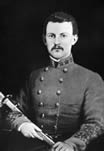
“All the men were up at once and ready, every officer at his post, Col. [Henry] Burgwyn in the centre,
Lieut. Col. [John R.] Lane on the right, Major [John T.] Jones on the left. At the command “Forward March!,”
all to a man stepped off, apparently as willing and as proudly as if they were on review. The enemy at once
opened fire, killing and wounding some…The enemy’s artillery on our right got an enfilade fire. Our loss was frightful.
But our men crossed [Willoughby’s Run] in good order and immediately were in proper position again, and
up the hill we went firing now with better execution.” (John R. Lane, Address at Gettysburg, 1905)
“Their advance was not checked, and they came on in rapid strides, yelling like demons. The Confederates
overpowered the Nineteenth Indiana, striking on both flanks. [The enemy] left was then exposed to an
enfilading fire and was forced to fall back. [Near the western crest of McPherson’s Ridge], the
Twenty-fourth Michigan fought desperately but the Twenty-sixth North Carolina would not be denied.
As Lane later recalled, “the engagement was becoming desperate, It seemed as if the bullets were
as thick as hailstones in a storm. At this time the colors have been cut down ten times, the color guard
all killed or wounded. We have now struck the second line of the enemy where the fighting is fiercest
and the killing is deadliest. Suddenly, Captain W.W. McCreery, Assistant Inspector General of the Brigade,
rushes forward to Col. Burgwyn. He bears him a message. “Tell him,” says General [James Johnston]
Pettigrew, “his regiment has covered itself with glory today.” Delivering these encouraging words,
Capt. McCreery…seizes the fallen flag, waves it aloft and advancing to the front, is shot through the
heart and falls, bathing the flag in his life’s blood.
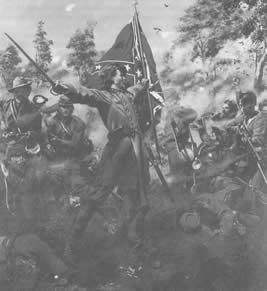
Lieut. George Wilcox of Company H, now rushes forward, and pulling the flag from under the dead
hero, advances with it. In a few steps he also falls with two wounds – not fatal – in his body.
The line hesitates; the crisis is reached; the colors must advance. The gallant Burgwyn leaps forward, takes
them up and again the line moves forward. Returning again from the right Lieut. Col. Lane sees Col. Burgwyn
advancing with the colors. At this juncture, a brave private, Franklin Huneycutt, of Company B, takes the
colors and Burgwyn turns to hear from the right. Col. Lane says: “We are in line on the right.” Col. Burgwyn
delivers Pettigrew’s message….At that instant he falls with a bullet through both lungs, and at the same
moment brave Honeycutt falls dead only a few steps in advance.
The night of Wednesday, 1 July 1863, would never be forgotten by those who survived the slaughter in
McPherson’s woods. The air was rent by the piteous cries of the wounded, many still lying in the fields
and woods, pleading for water, for succor of any kind, and even perhaps for the ultimate relief that only
death could afford. And none had suffered more than the men of the Twenty-sixth North Carolina.
Out of the approximately eight hundred who had been engaged in that bitter fight…hardly more than two hundred
were able to make their way back to the narrow woods on Herr Ridge.
Although victorious, the Twenty-sixth was virtually destroyed.”
(The Boy Colonel of the Confederacy, pp. 327-336)
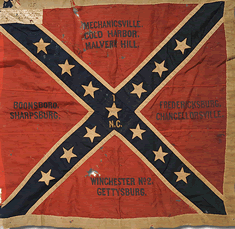
The Gettysburg Campaign -- The Third Day:
“Gettysburg was a national field of glory; but the paladins of the battle of July 3 were the native
North Carolinians, [General James Johnston] Pettigrew (born Tyrell County, July 4, 1828) and
Lewis Addison Armistead (born New Bern, February 18, 1817). Pettigrew, leading the spearhead of
the magnificent but forlorn attack, with reckless courage galloped along the advancing lines, giving great
shouts of encouragement to cheer on his men, through whose ranks huge gaps were being
torn by the enemy’s shells.
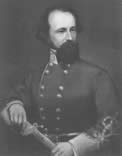
James Johnston Pettigrew
"Now Colonel, for the Honor of the Good Old North State, Forward."
After his horse was shot under him, Pettigrew led his men forward on foot until he himself was wounded.
Some scores of Pettigrew’s North Carolinians and Archer’s Alabamians and Tennesseans leaped the
stone wall east and south of the “bloody angle,” planted their standards there and drove back the first
Federal line from the wall; but these Confederates were quickly shot down, captured or driven back. In a
desperate gamble for victory, Armistead, leading a few scores of Virginians who followed his plumed hat held
aloft on the point of his sword, had penetrated to a point thirty-three yards east of the wall where he fell
mortally wounded; and most of his men were killed, wounded or captured.
North Carolinians of the division led by Pettigrew advanced to within twenty feet of the stone wall on their front,
about forty yards east of the point where Armistead fell. The easternmost point reached by Pettigrew’s
North Carolinians registered the “high water mark” of the Confederacy on this battlefield.
Pickett’s Virginians, first on the field to encounter the enemy, were the first to give way. Early in the action
[General] Garnett was killed and [General] Kemper grievously wounded. Col. E.P. Alexander, who
commanded the Confederate artillery, categorically states that “Pickett’s force was spent and his
division disintegrated before Pettigrew’s got under close fire.”
When [Northern] artillery opened on Pettigrew’s division, the fire was so devastating that, as [General] Trimble
observed, Pettigrew’s division “seemed to sink into the earth under the tempest of fire.” Responding lustily
to the stirring command, “Three cheers for the Old North State,” Pettigrew’s North Carolinians halted,
coolly returned the enemy’s fire, and then, giving a wild yell, dashed forward once again into the flame.
The North Carolinians sullenly withdrew from the field only after Pickett’s division was almost destroyed…
The desperate onslaught of the North Carolinians in this battle is fully attested by their opponents, who
by their own admission were on the verge of retreat; and the Confederate records attest the feats of valor
under devastating fire of the five North Carolina regiments in Pettigrew’s division which lost nearly as
many men in killed and wounded as the fifteen regiments in Pickett’s division.
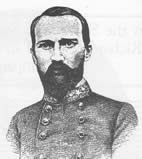
William Dorsey Pender
The highest ranking officer from North Carolina to fall at Gettysburg was William Dorsey Pender, to whom
Stonewall Jackson, after receiving his mortal wound at Chancellorsville, called out: “You must hold your
ground General Pender, you must hold your ground, sir.” Three weeks later he was promoted to major-general,
and the first battle he wore the stars of that rank was Gettysburg. On the second day he was mortally wounded
and died on July 18. General Pettigrew, a grandson of Charles Pettigrew, the first “bishop-elect” of the
Episcopal church in North Carolina, survived the final assault at Gettysburg, but on July 14 when his division
reached the Potomac he was wounded in a surprise attack by Federal cavalrymen and died three days later.
[On] July 20 the Carolina Watchman said editorially of Gettysburg: “We do not see from all accounts received
how the Yanks can claim it a victory, when, if they had been successful, they could have permitted the
defeated army to withdraw and march to Hagerstown without pursuing it.”
(North Carolina, The Old North State and the New, pp. 257-259)
"[Pettigrew] was the highest ranking officer still on his feet in the brigade, and he had been wounded twice.
Every other colonel, lieutenant colonel, and major in the North Carolina brigade was dead or badly wounded
except for one who had been captured a few yards from the stone wall. The Twenty-sixth North Carolina had
gone into the first day of Gettysburg with more than 800 men and cam out with 216. After the third day's
action there were eighty men present for duty, a good-sized company.
On 7 July...Pettigrew dashed off a note to Governor [Zebulon] Vance, in as tone as exultant as a victor,
telling him that his old regiment, the Twenty-sixth, had covered itself with glory.
"None had more deeply at heart than he the cause for which he shed his blood," wrote Colonel [Collett] Leventhorpe.
"He gave himself up to it wholly, with all his fine energies, extraordinary talents, and the courage of a heart literally
ignorant of fear...I tell you the truth when I say that I have never met with one who fitted more entirely my "beau ideal"
of the patriot, the soldier, the man of genius, and the accomplished gentleman."
(Carolina Cavalier, pp. 200-205)
The Aftermath of Gettysburg:
Twenty-year old Captain Oliver Evans Mercer of Company G, 20th North Carolina Regiment was killed on the
first day of fighting at Gettysburg. Mercer joined the “Brunswick Guards” at Camp Howard in Brunswick county
in June 1861. Not knowing of her son’s fate in the battle, Mercer’s mother wrote Virginia-born Dr. J.W.C. O’Neal
who was identifying, recording and burying the Confederate dead left on the battlefield:
“Our Wilmington papers bring the welcome intelligence to many bereaved Southern hearts that you have
cared for the graves of many of our confederate dead at Gettysburg, replaced headboards and prepared a
list of names. May the Lord bless you is the prayer of many Southern hearts. Oh! We have lost so much.
There are but few families that do not mourn the loss of one or more loved ones, and only a mother who
has lost a son in that awful battle can and does appreciate fully such goodness as you have shown.
I, too, have lost a son at Gettysburg, a brave, noble boy in the full bloom of youth, and my heart yearns to
have his remains, if they can be found, brought home to rest in the soil of the land he loved so well. I need
your assistance and I am confident you will aid me. No sorrow-stricken mother could ask and
be refused by a heart such as yours.”
(Debris of Battle, Gerard A. Patterson)
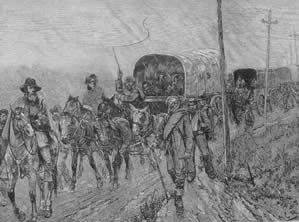
Northern Raid in North Carolina – July 19-23, 1863
"A band of the Union troops almost seized former North Carolina governor Henry T. Clark at his plantation
home just outside of Tarboro. On the morning of the raid Clark was preparing to start his daily
horseback ride when he spotted the approaching Yankee cavalrymen. The soldiers sighted the former
governor, and what would have been just a peaceful ride on a summer morning became a desperate
dash into the woods. Unable to catch Clark, the Union troops returned to loot his house. The State Journal
reported that "Ex-Gov. Clark's residence, on the suburbs of the town, was shamefully abused. Mrs. Clark
and her niece, Miss Bettie Toole, were compelled to leave their house and take refuge in the kitchen.
They ransacked the house from top to bottom, breaking open trunks, chests, and drawers." Much of their
food was stolen, thrown down the well, or otherwise ruined, and the raiders plundered Clark's "stock
of wines and brandies.”
The Federal soldiers also raided the Branch Bank of Tarboro; fortunately, the valuables entrusted to the bank
had been taken away and hidden. The bank cashier was robbed of his watch and clothing while the raiders
searched the bank. The luckless cashier's home was also plundered that day. From Tarboro's Masonic lodge
the raiders "carried off the fine regalia of the Chapter and all the jewels and emblems even to the common
gavel, and damaged what could not be removed.”
(The Yankees Have Been Here, NC Historical Review, David A. Norris, January, 1996, pp. 12-13)
The Wilderness Campaign:
Spotsylvania: "A Butchery Pure and Simple"
“Elsewhere along the front, Grant had ordered attacks by all four Union corps against various points
of the Confederate fortifications. Most of these assaults failed to produce any positive results,
except a…charge that penetrated [General Richard] Ewell’s breastworks. The stalemate around
Spotsylvania continued. That evening [May 10, General Harry] Heth marched his division back to
reoccupy the ground on the far right in front of the Spotsylvania Court House. The 11th and 44th
North Carolina took up positions near an eastern bulge in the defensive line known as “Heth’s Salient.”
That night Lee, A.P. Hill, and several other generals congregated at Heth’s headquarters
in the Massaponax Church. A discussion arose among the generals about Grant’s tactics.
Unlike any other Union general they had fought, Grant had launched sudden assaults against
them on May 5, 6, 8 and 10. These attacks failed to overpower the Confederates and
cost thousands of Union lives. Grant’s aggressiveness not only amazed
the senior officers, it also appalled them.
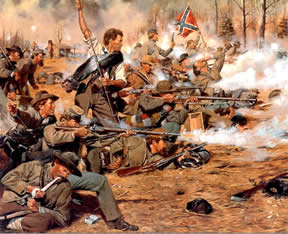
The Confederate generals severely criticized Grant’s bludgeoning tactics. To their astonishment,
General Lee voiced a different opinion. More than any other Confederate general, Lee understood
that Grant’s pugnacity had smothered their ability to strike a powerful counterblow. Heth, Hill,
and the others saw the body count and thought they were winning.
Lee saw an opponent who kept attacking and worried.
[Lee] predicted Grant would withdraw in preparation for another move toward Richmond or Fredericksburg.
He then expressed a desire to attack Grant’s forces as they moved. Lee turned to Heth and
said, “I wish you to have everything in readiness to pull out at a moment’s notice, but
do not disturb your artillery, unless you commence movement. We must attack these
people if they retreat.” Lee rebutted their arguments with a remarkable insight:
“This army cannot stand a siege; we must end this business on the battlefield, not in a fortified place.”
Before dawn [on May12], Grant launched yet another massive assault against the Confederate
defenses. By 5 [AM] o’clock the engagement had become very hot. Burnside’s attack pressed
against pockets of the 11the North Carolina [and] Lt. Col. Frank Bird [of Bertie county] described
the savage fighting as “the hardest fought battle probably of the war.” The enemy made repeated
charges on our works but was repulsed with most terrible slaughter…I am unhurt, how I am unable
to say. I have been in the hottest battles.”
Despite the intense combat and persistent Union assaults, the regiment suffered only light casualties.
Frank Bird explained the disproportionate loss rate to his sister: “The accounts which you see in the
papers of our having killed and wounded so many more of them [Union troops] than they of is, are
not I think exaggerated. The difference is truly wonderful and I only account for it in one way. They
advanced on us in so many lines of battle, and were therefore so thick that we could not miss them.”
Although the regiment suffered little, personal tragedy struck Lewis Warlick [of Burke county]. Pvt. Logan
Warlick, his brother, was one of the few men killed on May 12. Warlick wrote home to his sister-in-law
to break the sad news to the family. A second Warlick son had died while serving in the Bethel Regiment.”
“Grant is twice as badly whipped as was Burnside and Hooker but he is so determined
he will not acknowledge it,” wrote Warlick.”
[The 11th North Carolina, or “Bethel Regiment,” was comprised of men from Mecklenburg, Burke, Bertie,
Chowan, Orange Lincoln and Buncombe counties.]
(More Terrible Than Victory, pp. 166-170)

Southern women during the war were known to have destroyed their precious libraries than to
allow Northern occupiers to enjoy its contents, as well as knocking in the heads of wine casks rather than
permitting Northern soldiers to sample their choice contents. The author of the following was
born in Indiana, migrated to Virginia in 1857 and later served in the Nelson (Virginia) Light Artillery.
The Temper of the Women:
“During the latter part of the year in which the war between the States came to an end,
a Southern comic writer, in a letter addressed to Artemus Ward, summed up the political
outlook in one sentence, reading somewhat as follows: “You may reconstruct the men, with your
laws and things, but how are you going to reconstruct the women? Whoop-ee!”
Now this unauthorized but certainly very expressive interjection had a good deal of truth at its back,
and I am very sure that I have never yet known a thoroughly “reconstructed” woman.
The reason, of course, is not far to seek.
The women of the South could hardly have been more desperately in earnest than their husbands
and brothers and sons were, in the prosecution of the war, but with their women-natures they gave
themselves wholly to the cause.…to doubt its righteousness, or to falter in their loyalty to it while
it lived, would have been treason and infidelity; to do the like now that it is dead would be
to them little less than sacrilege.
I wish I could adequately tell my reader of the part those women played in the war. If I could
make these pages show half of their nobleness; if I could describe the sufferings they endured, and tell
of their cheerfulness under it all; if the reader might guess the utter unselfishness with which they
laid themselves and the things they held nearest their hearts upon the altar of the only country
they knew as their own, the rare heroism with which they played their sorrowful part in
a drama which was to them a long tragedy;
[I]f my pages could be made to show the half of these things, all womankind, I am sure, would tenderly
cherish the record, and nobody would wonder again at the tenacity with which the women of the
South still hold their allegiance to the lost cause.
Theirs was a particularly hard lot. The real sorrows of war, like those of drunkenness, always fall
more heavily upon women. They may not bear arms. They may not even share the triumphs which
compensate their brethren for toil and suffering and danger. They must sit still and endure. The poverty
which war brings to them wears no cheerful face, but sits down with them to empty tables
and pinches them sorely in solitude.
After the victory….[the] wives and daughters await in sorest agony of suspense the news which may
bring hopeless desolation to their hearts. To them the victory may mean the loss of those for whom they
lived and in whom they hoped, while to those who have fought the battle it brings only gladness.
And all this was true of Southern women almost without exception.
[The] more heavily the war bore upon themselves, the more persistently did they demand that it should
be fought out to the end. When they lost a husband, a son, or a brother, they held the loss only an
additional reason for faithful adherence to the cause. Having made such a sacrifice to that which was
almost a religion to them, they had, if possible, less thought than ever of proving unfaithful to it.”
(A Rebel’s Recollections, George Cary Eggleston, Indiana University Press, 1959, pp. 83-85)
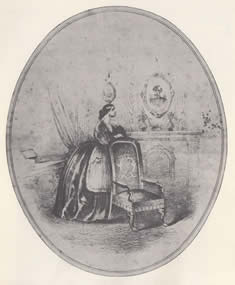
Cold Harbor:
"[Governor Zebulon] Vance received a letter from Petersburg, Virginia, dated July 20, 1864, which showed how
heavily the anguish of war bore on both sides. Captain john S. Dancy of the 17th North Carolina wrote of Grant's
ill-conceived assault on the Confederate lines:
"I forward you a Yankee flag captured at Cold Harbor, Virginia, on the 3rd of June 1864 by the 17th N.C. Regt.,
Col. W.F. Martin. It belonged to the 164th N.Y. Volunteers, who charged boldly up to within seventy-five yards of
the lone of the 17th Regiment and were literally cut to pieces. A few prisoners captured by us stated that themselves
and three others who reached their lines safely were the only ones left of the Regt. All the field and company officers
were killed in the immediate front of the 17th and the Yankee bodies were literally piled upon one another.
I forward the flag to you as the Executive of the State, with the hope that it may be taken care of or measures
taken to remember it as the capture of the 17th N.C. Regt."
(Zeb Vance, Champion of Personal Freedom, page 387)
The Petersburg Campaign:
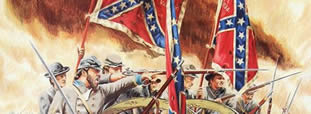
Living Skeletons Defending Petersburg
“After the Union disaster at “the Crater,” the armies returned to three weeks of uneventful trench warfare.
During the first twenty days of August [1864], “nothing occurred with us to break the monotony
in the trenches, such as it was,” according to [General Johnson] Hagood. [General Alfred H.]
Colquitt’s brigade was permanently returned to Hoke on August 2.
On August 19, [Colquitt’s, Hagood’s and General Thomas L. Clingman’s brigades were assigned
to General William Mahone] in Lee’s unsuccessful three-day effort to dislodge the Federals from
the Weldon and Petersburg Railroad. Of the 681 officers and men Hagood sent into the battle,
only 292 emerged unscathed. General Clingman was seriously wounded in the
leg on the first day of the engagement and was lost to Hoke for the remainder of the war.
Because of deadly attrition and the casualties sustained on August 21, Hagood asked that
he be allowed to take his survivors “to some quiet camp where rest and access to water
might recruit their physical condition.” His request was granted by Lee.
When the 740 frail soldiers of his command emerged from the Petersburg trenches on August 20,
they represented just a third of the complement that had entered the works sixty-seven days earlier.
The brigade inspector was delighted when a local citizen offered his forty-acre estate in
nearby Chesterfield County for a camp site.
In mid-September, Hoke was granted permission to pull his other weary brigades from the
trenches and take them to the utopia being enjoyed by Hagood’s men. Of the twenty-two
hundred soldiers on hand when Brigadier-General [James G.] Martin put his soldiers in
the trenches, seven hundred “living skeletons” scrambled out under the command of
General [William W.] Kirkland on Thursday, September 15.
For ten days, Hoke and the worn and jaded men of his division enjoyed overdue pleasures.
In a letter to his sister, Lieutenant Edward J. Williams of the Thirty-first North Carolina
expressed the excitement that abounded: “The most pleasant topic amongst us . . .
is that we are at last clear of the ditches, shells, & [bales] of every description & are lying
at ease on a beautiful hillside washing our faces at least once per day and no work to do.
Since the 15 of June we have held a portion of the works in front of
Petersburg & have never been relieved until now.”
The brief respite from war ended all too soon on September 28, when the men returned to the trenches.
As a climax to the period of rest and relaxation, the division was honored with a grand review by General Lee
. . . dressed in full uniform with a yellow sash, was atop Traveller as he rode past the
remnants of Hoke’s four brigades.”
(General Robert F. Hoke, Lee’s Modest Warrior, Daniel W. Broadfoot, John F. Blair, 1996, pp. 218-219)
A Glorious Victory---North Carolinians at the Battle of Ream’s Station:
"On August 25, 1864, the three brigades of North Carolinians under Generals James H. Lane,
John R. Cooke and Wilmingtonian William MacRae were concentrated in a wooded area opposite the right
flank of Northern forces. MacRae had told his men that he knew they would go over the enemy works, and
that he wished them to do this without firing a gun.
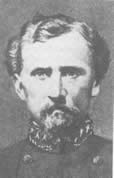
Gen. William MacRae
The artillery fire of Col. William J. Pegram swept the enemy forces before the brigades advanced
late in the afternoon, charging up to the Northern earthworks and fighting hand to hand---ending
with a full rout of the enemy. MacRae had instructed Lt. W.E. Kyle and his sharpshooters to concentrate
upon the Northern artillery batteries firing at his forces, thus eliminating this threat. Once captured, the
guns were turned upon the fleeing enemy by Captain W.P. Oldham of Wilmington and his men of
Company K of the 44th North Carolina who opened a devastating fire.
“In a moment of panic our troops gave way,” a Northern colonel wrote (and) soldiers either threw themselves
on the ground in surrender or fled across the railroad. Never in the history of the Second Corps
had such an exhibition of incapacity and cowardice been given, a Northern soldier asserted. Author James
Robertson’s states in his “A.P. Hill, Story of a Confederate Warrior” that “of the 2700 (Northern) casualties,
2150 had surrendered on the field…in addition, the [Northern] army had lost 9 cannon, 3100 small arms and
32 horses. The [Northern commanding general] was so humiliated by the rout at Ream’s Station that
he submitted his resignation from the army.”
Col. Pegram’s artillery battalion thought very highly of MacRae’s brigade and felt that their guns could never
be captured by the enemy with MacRae supporting them. General Robert E. Lee publicly and repeatedly
stated that not only North Carolina, but the whole Confederacy, owed a debt of gratitude to Lane’s, Cooke’s
and MacRae’s brigades which could never be repaid---and personally wrote to Governor Zebulon Vance expressing
his high appreciation of their services. In his letter to Vance, Lee stated “If the men who remain in North Carolina
share the spirit of those they have sent to the field, as I doubt not they do, her defense may securely be
trusted to their hands.”
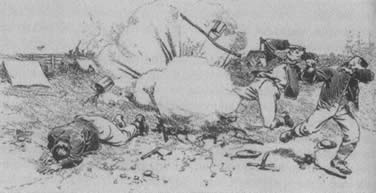
It is said that the great success of the assault at Ream’s Station was largely the result of the keenness of
MacRae in selecting the right moment to strike at the enemy without awaiting orders to do so. At his next major
engagement with the enemy at Burgess’ Mill in October 1864, MacRae’s brigade once again displayed coolness
and gallantry in battle. After an assault that broke the enemy line and captured an artillery battery, his brigade was
left unsupported while an enemy counter-attack closed upon his flanks. A desperate struggle to hold his position
ensued until nightfall, when his brigade fought through the new enemy lines that were forming to their rear.
The brigade entered that battle with 1,050 troops, with all but 525 being casualties of the engagement.
Though many times in exposed and dangerous positions himself, General MacRae suffered only one wound to the
jaw, and his uniform was pierced often by bullets and shrapnel. His sabres suffered the most damage with
two being cut in half by shots. Though he lacked formal military training, MacRae was described as
“one of the finest brigade commanders in Lee’s Army of Northern Virginia” and a brilliant tactician knowing
when best to strike an enemy, and where.
General MacRae and his brigade were not involved in the second Battle of Hatcher’s Run of February 1865 in
which some Southern units suffered severe losses. General A.P. Hill recognized MacRae’s value to his army
and later testified that “had William MacRae been here, the result would have been different.”
(Wilmington's Fighting Brigadier, www.cfhi.net)
Pocket Bible Saved His Life:
“With a loud cry, the Confederates advanced, forcing the Federal pickets to flee toward their main lines.
A few moments later after Lane and Cooke had made contact with the Federals, another Confederate brigade,
under General [William] MacRae, crashed into the Federal works and gained a foothold inside.
The Thirty-seventh [North Carolina], positioned near the center of Lane’s brigade, made the next
breakthrough. Hysteria-stricken Federal soldiers streamed to the rear. The Federal officers attempted
to get their men to counterattack, but their efforts were in vain, as the Union soldiers started
surrendering or heading for the rear.
But the fire concentrating on the Thirty-seventh was intense. “in gaining this point,” Major Bost would write,
“the Regt was exposed to a heavy fire of grape shot and bullets.” Portions of Lane’s brigade started falling
back, while other portions, including most of the Thirty-seventh, intermixed with elements of Cooke’s brigade,
pressed ahead, “capturing prisoners, caissons, horses…” Much of the fighting was done hand to hand.
Private Thomas M. Hanna (Company H) was one of the soldiers slightly wounded during the battle.
He would pen this account of his ordeal to his wife a few days after the battle:
“Dear wife:…God has spared my life through another bloody battle…The day I commence it we
were marched all night and fought the Yankees at Ream Station….we had to march 20 miles to get around
them in the hottest weather I ever felt. We had a desperate fight, made the attack and drove them from
their breast works…We also lost pretty heavily…I myself slightly wounded in the right breast. The ball struck
my pocket bible, and went halfway through it. [It] kill[ed] a man dead just in front of me and the doctor said it
would have killed me if it had not struck my pocket Bible.
A Gaston County pastor would relate many years after the war that the bullet had made “a track through
[the Bible] from Genesis to John…” and that the minie’ had come to rest on the “14th chapter of John…
”Peace be with you, my peace I give unto you.” Hanna would continue in his letter to his wife after the battle:
“I don’t know what I will do for a Bible, mine is ruined, torn and bursted all to pieces.”
(The Thirty-Seventh North Carolina Troops, Michael C. Hardy, pp. 207-209)
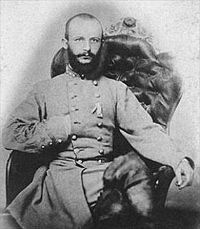
General Stephen Dodson Ramseur’s Furlough:
To oppose Sheridan’s army of about fifty thousand men [in the Shenandoah Valley in Autumn 1864],
[General Jubal] Early had four small divisions of infantry, a little cavalry and artillery, less than twenty thousand
in all. [General] John B. Gordon, commanding one of Early’s brigades…saw Sheridan’s camps spread out
below him in the Valley, and saw that the left flank was weak and could be turned. He was given three divisions,
his own and those of [General Stephen D.] Ramseur and [General John] Pegram, with which to cross the
mountain and attack the Union flank and rear….The attack was to be made just
at daybreak of October nineteenth.
Through the night before, quietly and secretly, the flanking column filed over the steep mountain.
Gordon and Stephen Ramseur, young North Carolina Major-General, sat on a bluff overlooking the
movement, through the night.
Ramseur had married since the war began; to him had been born a daughter, whom se had never seen.
He talked that night of the daughter, and of the young mother, and of his deep longing for a pause
that he might go home. As dawn he rose and started to his place in the battle line. “Well, Gordon,” he
remarked quietly and with perfect assurance, “I shall get my furlough to-day.”
Before the battle was old he had it, a furlough for ever.
The death of the inspiring Ramseur, however, did not slacken the charge of his division, nor that of the
other Confederate flanking forces. Their attack was irresistible, sweeping the field of their surprised and
routed enemies, until but one of the Union corps held its organization and showed resistance.”
(The Story of the Confederacy, Robert Selph Henry, Bobbs-Merrill Company, 1931, page 412)
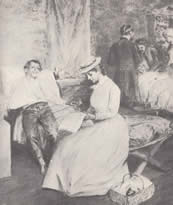
Incidents of Hospital Life
“My husband was wounded on the 6th of May, 1864, at the battle of the Wilderness, and was captured
on the 20th. After he was captured he wrote me a letter, giving it to a man at Port Royal, Va., to mail,
which he did not do until the latter part of July. Just imagine my terrible anxiety,
not hearing from him in all that time.
In October I started home, leaving my little daughter with my sister, who expected to follow me
the next month. I took my little ones and my niece, who was a young lady, with me. My sister was
taken ill and I did not see my little girl until the following July. My husband, being still a prisoner, was
carried with the [600 Confederate] officers to Morris Island, and was under the fire there for forty-two days,
and from there he was taken to Fort Pulaski.
How I lived through that winter I cannot tell. After Christmas I applied to Dr. Essington for a situation as
assistant matron to the lower hospital. They were bringing the wounded from Fort Fisher, Wilmington, and
other points. We already had one hospital and were establishing another. I shall never forget the doctor’s
look of amazement when I applied for the situation. My reply was: “Doctor I don’t want any pay, but I must
have constant occupation or I will [lose] my mind.”
I went every morning at nine o’clock and staid until one, and I always went late in the afternoon to see that
the wants of the patients were attended to during the night. I always dressed all the wounds every morning,
and I soon found that my grief and sorrow were forgotten in administering to the wants of the sick.
Such patience and fortitude I have never seen. Not one murmur did I ever hear escape their lips.
My prayer book was my constant companion. I carried it in my pocket, and many a poor soldier have I soothed
and comforted with holy prayers. One day as I entered the hospital I noticed a new face. I made my way to him,
as I was struck by his gray hair, and said: “You are too old to be here.” He smiled and his answer was
quite a rebuke. “One never gets too old to fight for one’s home and fireside. I had no sons, so I came myself.”
He proved to be a Mr. Johnson from Georgia. I made him my especial care, but to no avail.
He died on the 8th of March [1865].
Now I will speak of another soldier who died the same day. His name was Sanford, and he was just in
the prime of life. It was really pathetic the way he spoke of his wife and home. The surgeon promised
him a furlough, and when I went and told him we had written for his wife to come and take him home
I shall never forget his expression as he exclaimed: “am I to see my wife and home.”
Alas! the poor fellow did not live to see his wife again.
On the 10th of March [General William] Hardee’s men commenced to pass through Fayetteville. It was a
day of humiliation and prayer. When I left the hospital I told them they would have to do without me
the next day as I wanted to do what I could towards feeding some of our hungry soldiers, as we had nothing
but bread and meat to give them.
My uncle, Dr. Kyle, went with me, and we stood in the store door on Hay street. We soon attracted the
attention of a soldier and told him what we wished to do. My uncle, myself and two servants were kept busy
the whole day. Three of my neighbors and myself prepared the bread and meat. It was enough to make
anybody’s heart ache to see the ragged men.
One came forward. He looked like a boy of eighteen or nineteen. He had a little iron pot and I said:
“Child, you look so [tired], why do you carry that iron pot?” and he answered: “I keep it to cook with.”
I offered him a twenty-dollar Confederate note for it, with which he bought twenty loaves of bread
and divided it among his comrades. When night came on I closed the door with a heavy heart.
They were still coming.”
(Incidents of Hospital Life, Mrs. Anne K. Kyle, War Days in Fayetteville, Reminiscences of 1861 to 1865,
JEB Stuart Chapter, UDC, May 1910, pp. 39-42)
Fort Fisher to Bentonville:
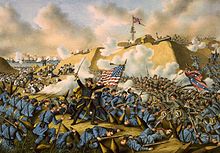
Fort Fisher:
“From the beginning of the war Wilmington had been the chief, and for the last two years the only
Confederate port to and from which blockade runners could ply with any degree of safety. North Carolina
took advantage of this fact to buy and run a fast steamer [the Advance], whereby she was enabled to
keep her soldiers better clothed and better supplied with shoes, blankets and medicines than the
soldiers of any other States of the Confederacy. It had long been a matter of surprise that a vigorous
attempt to capture the place had not been made by the United States Government.
[Fort Fisher] had a land-front of six hundred and eighty-two yards, and a sea-face of one thousand eight
hundred and ninety-eight yards, both of which had heavy parapets intersected by great traverses.
A palisade ran about fifty feet in front of the land-face, and a line of sub-terra torpedoes lay about
two hundred yards in front of it, connected with the fort by wires. It was built and commanded by
Colonel William Lamb, of Norfolk, Virginia, under the general supervision of General [William Henry
Chase] Whiting, commanding the [Cape Fear] district.
During the night of the 12th of January, 1865, the [enemy] fleet, now increased in number to fifty-eight ships,
besides the transports and four monitors, reappeared [after a first inconclusive attack in late December],
and early on the morning of the 13th some of them drew into shore, at a point about four miles above
New Inlet, furiously shelled the woods of the peninsula for some time, and then the disembarkation of
the troops began, at a point just above the head of Masonboro Sound.
[By 3PM]…the enemy troops [8,500] were all landed….There was no opposition to their landing and
General Bragg claimed afterward that it would have been useless to oppose them. “No human power,”
he said, “could have prevented the enemy from landing, covered as he was by a fleet of ships
carrying six hundred heavy guns.” He may have been right, but his failure to attack them, at least
at night after their landing, was certainly a great surprise and disappointment to the garrison
of the fort, and to all outside of it.
All of the 13th and 14th, the fleet kept up an awful fire on the fort, and especially on the land-face, which
was subjected to both a direct front and rear and an enfilading fire of the most terrible intensity. Every
one of the twenty-two heavy guns on this face, except one 10-inch Columbiad, was dismounted;
every Napoleon except one was rendered useless; every wire leading to the mines was torn up, and
the palisade was knocked into “such a wreck as actually to offer a protection to some of the assailants.”
Fifty thousand shells were expended by the fleet in this work.
General Whiting, who had been quietly superseded in the command at Wilmington by Bragg, and who was
a very accomplished and brave officer, went down with his staff to the fort, and, saluting the commanding
officer with the words, “Lamb, my boy, I have come to share your fate; you and your garrison are to be
sacrificed,” went to work assisting and advising, but refused to take command.
Sunday, the 15th, about 3 P.M., the fleet…changed its fire from the land-front to the left, and along the
sea-face…and [the enemy commenced its assault with two thousand men on the] northeast salient, where
they were met by Whiting and Colonel Lamb with about five hundred men, and after a struggle of half and
hour or more were driven off with the loss of about three hundred. The assault of two [enemy] brigades on
the left was met by about two hundred fifty men [who] repulsed the assailants twice, but were soon surrounded
and overwhelmed by the greatly superior force, who captured several of the traverses before the rest of
the available force, about eight hundred men, could confront them.
The brave Whiting…now led the counter assault on the enemy and was shot down. Then commenced a
hand-to-hand struggle of the most desperate character on the parapet and over a traverse; and the guns on
the “Mound” and at Battery Buchanan being now turned on the enemy. At this moment Colonel Lamb,
who was in the act of ordering a charge, was also shot down.
This was about 5 o’clock P.M….Splendid courage was exhibited by the devoted garrison, who fought
on against overwhelming numbers for nearly five hours longer. [An enemy officer reported that] For the
first few minutes [of the assault], out of every five who gained the parapet three went down, dead or wounded.”
It was 10 o’clock at night before the final surrender was made, when two thousand and eighty-three officers
and men were captured [by the eight thousand five hundred, minus casualties].”
(An Address to the Association ANV, Alfred Moore Waddell, pp. 14-21
General Whiting Inspires His Men
“Fort Fisher had become a killing ground. Thousands of gray and blue-uniformed soldiers were
locked in a fierce struggle on the battlements, stabbing and slashing with their bayonets and swords,
firing their rifle-muskets at point-blank range, clubbing with their musket stocks, beating each other
with their fists. “The fight was very desperate and bloody,” General [W.H.C.] Whiting exclaimed.
One of [his] soldiers, Pvt. James A. Montgomery [of New Hanover county] of 3rd Company B, 36th
North Carolina Regiment,described the battle as “a soldier’s fight.” When one soldier fell, another
sprang forward to take his place, with officers loading and firing alongside their men.
Montgomery noted, “We were too close to fire.”
On the western salient’s third traverse [General] Whiting wrestled with a Union standard bearer for
possession of the U.S. flag. Easily recognizable in his general officer’s tunic, Whiting defied danger to
join his men at the front. Two Yankee minie balls pierced his right leg, crumpling him to his knees. Although
[Whiting’s] fall stunned his soldiers, they continued the furious struggle for the western salient. Under
Whiting’s inspired leadership, they had already regained control of one traverse.
“The Rebel’s attacked our men like savage dogs,” exclaimed E.D. Williams of the 117th New York.
The Confederates would “jump up on top of a traverse and shoot down upon our men, and if that
failed, they would attempt their slaughter with clubbed muskets,” explained a New York soldier.
Minie balls took an even greater toll than bayonets, and the wounds at close range were often fatal.
According to Cpl. Henry Clay McQueen [of Robeson county] of Company D, 1st Battalion North Carolina
Heavy Artillery, “a comrade next to me on the traverse was shot in his brains and killed.”
Grudgingly, the vastly outnumbered Confederates yielded to the overwhelming Federal force
that advanced slowly eastward from one traverse to the next.”
(Last Rays of Departing Hope, pp. 281-282)
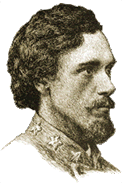
Colonel Lamb's Counter-Attack
“[Colonel William] Lamb believed that his efforts would turn the tide of battle in the Confederates favor.
For a time it appeared that the Confederates had stalled the Union advance. The Southerners fire
was so destructive that [the Northerners] either plunged to the sandy floor of the fort’s parade ground
or took shelter behind nearby traverses along the land face….”acres of men lying on their faces
crowded together so thickly there was no room to lie down.”
Because of the defenders’ severe artillery and small-arms fire there was little protection for the Federals
unless they hugged the ground. [Colonel] Lamb determined to lead a counterattack against [the] troops
on the floor of the fort, where they were now beginning to entrench. Lamb passed down the rear of
his line, asking his officers and men if they would follow him. “They all responded fearlessly that
they would,” Lamb recalled proudly. The colonel quickly organized his line of battle, then sprang to
the top of a breastwork and yelled, ”Charge bayonets, forward, double quick, march!”
But at the instant Lamb uttered the command to advance, a minie ball ripped into his left side and
sent him sprawling into the sand. One of Lamb’s best officers, Lt. Daniel R. Perry [of Bladen county] of 3rd
Company B,36th North Carolina Regiment, was mortally wounded by the colonel’s side. While the
Yankee volleythat wounded Lamb and killed Perry was fired too high to be effective against Lamb’s rank
and file, it succeeded in stalling the attack. The Tarheels withdrew behind their defenses.
Severely wounded, Lamb turned his command over to Capt. Daniel Munn [of Bladen county], telling him
to keepthe enemy in check and that he would rejoin the fight as soon as his injury was bandaged.”
Across the Cape Fear River, a group of ladies watched the terrible battle for Fort Fisher from bluffs
on the west bank. Their stake in the struggle was a dear one, for their husbands and sons were among
the fort’s defenders. One of the observers was Mrs. T.C. Davis, whose husband, Sgt. Thaddeus C. Davis
[of Carteret county] of 3rd Company G, 40th North Carolina, was a member of the fort’s garrison.
“At times my imagination would tell me that my anxious eyes were resting upon him in that
little group of heroic defenders. The next instant a monster shell would explode in their midst,
enveloping everything in smoke and dust. At such moments I would feel as if my heart
would burst. When the smoke would lift, we could see distinctly the lines engaged often in
hand to hand fighting; but O! we could see so distinctly that the thin, gray line was growing
thinner, and that the dark, heavy masses were growing heavier.”
(Last Rays of Departing Hope, pp. 283-286)
Monroe's Crossroads: "We Fell Upon the Camp like a Small Avalanche:
"The first traces of dawn colored the eastern sky at 5:20AM on Friday, March 10, 1865.
[General Wade] Hampton and his Southern horse soldiers stood poised for the attack.
“Follow me men,” cried Hampton, his voice ringing out for all to hear. “Charge!”
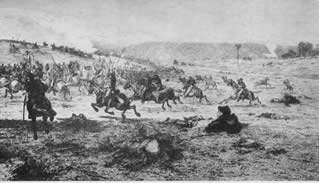
“In a moment the cavalrymen were dashing with a magnificent Confederate yell through [Northern General]
Kilpatrick’s camp.” One of the legion’s officer’s recalled that we “fell upon the camp like a small avalanche.”
The surprise was overwhelming. “Our Brigade swept out everything clean,” recalled Col. J. Fred Waring, the
commander of the Jeff Davis Legion Cavalry of Wright’s Brigade. “Great numbers of the men were sabered
while rising from their blankets,” recalled [a Northern soldier].
Trooper Posey Hamilton of Hagan’s Alabama Brigade thought he knew which tent [General Judson]
Kilpatrick was in, so he and his friends were determined to nab the unsuspecting Federal commander in his
bed…[though] Kilpatrick was in the Monroe House.
General Anderson’s troopers managed to find a narrow trail through the swamp, but they had to squeeze
together to make it across. The horsemen from his 5th Georgia Cavalry approached so stealthily that
none of the sleeping Federals stirred until “one of the couriers (following the General) put the point of his
saber through the blanket of one of the sleeping guards, who started up, and, by his outcry, woke the sleepers.”
Anderson headed toward the Monroe house [and] in spite of the Federals fighting on foot with repeating
carbines, the 5th [Georgia], mounted and using pistols only, broke them and after a brief scrimmage
they fled.” Kilpatrick’s bugler was seized just as he was bringing his horn to his lips. He never got the
chance to warn the rest of the camp.
“The Yankee camp looked like a cyclone had struck it all at once,” recalled trooper Posey Hamilton.
“Their blankets were flying in the air, and then men were running about in every direction…while the men
from the big tent were legging and heeling it down the hill to beat the band. If this was not
a stampede on foot, then I never saw one.”
Hearing unusual noises and the pounding of hooves in his camp, Judson Kilpatrick left Alice and the warmth
of his bed to find out what was going on. What he saw stunned him: enemy cavalry was mingled with his
troopers, swords slashing and pistols drawn. “Here is four years’ hard fighting for a major-general’s commission
gone up with an infernal surprise,” was the first thought that went through…[his] mind as he watched
helplessly from the porch. The next day while writing his report of the battle…[he stated], “Hampton led the
center division and in less than a minute had driven back my people and taken possession of my
headquarters, captured the artillery, and the whole command was flying before the most formidable
cavalry charge I ever have witnessed.”
Abandoning Alice to her fate, [Kilpatrick] jumped astride the nearest horse and dashed off toward the
safety of the swamp, still clad only in his nightshirt. Edwin L. Wells of the 4th South Carolina Cavalry…
watched “a sorry looking figure in his shirt and drawers” run from the front porch of the house [and] “tarried
not on the order of his going.” All his horses and personal effects fell into the hands of the swarming Confederates
who quickly claimed them as prizes. “The General left his sword, uniforms, boots, also a woman,
presumably his wife,” recalled one of [General Joe] Wheeler’s horsemen.
The ecstatic Confederate prisoners who had recently fallen into Union hands realized that their day of
liberation had arrived. “As soon as our men who were prisoners heard the shots they told the guards:
“That is Wheeler charging; you had better save yourselves,” recalled one of [Capt. Alexander M.] Shannon’s Scouts.
The guard dashed away and the prisoners began to help themselves to arms, horses, and whatever they wanted.”
(The Battle of Monroe’s Crossroads, pp. 132-143)
Averasboro:
“During the [Northern] bombardment, [General William B.] Taliaferro rode to [Capt. Gustave] LeGardeur’s
[Louisiana] battery to ascertain why the Southern guns were not returning the enemy’s fire.
Taliaferro spotted a sergeant of the piece standing beside his gun, his elbow resting on the muzzle. A furious
Taliaferro demanded, “What is the matter?” The sergeant pointed to “the carriage and caisson, with every mule
lying dead. A shell had burst on the cannon, killing everyone but him.”
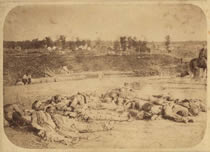
In just a few hours, the [enemy] artillery expended an estimated 170 rounds. Given this heavy fire it is no
wonder that the [enemy] artillerists inflicted such a heavy toll on the Confederate position. Two of [the enemy]
regiments carried seven-shot Spencer repeating rifles and would not have to stop to reload after each shot,
meaning that they could bring to bear tremendous firepower…”pouring volley after volley from our Spencers.”
[The assaulting enemy] could see the large number of Confederate dead and wounded left behind by the
routed South Carolinians. “It was the terriblist slaughter of men that I ever witnessed,” observed
[one],…”In the mud in the bottom of the ditch he [a Confederate artilleryman] had been hit by a
cannon ball from one of our guns, wrote [another].
An artillery shell had penetrated six feet of earth works,
tearing “off the whole right side of his body.” Remarkably, the man was still alive, and begged the Federals to
shoot him. The poor soul only wanted to be put out of his misery and pain; but he only lived a few minutes.”
[Another] saw a similarly horrific sight when he entered the Confederate works. “I saw one man Confederate at
least, with a hole made through his breast as slick as you could have bored it with an augur.”
The Confederates had suffered terrible losses. The 1st South Carolina Heavy Artillery had borne the brunt
of [the] assaults and suffered heavily, losing 215 killed, wounded or captured out of 458 officers and men
engaged. [Colonel William] Butler had gone into battle with 1,051 men that morning and…
lost an astounding 62% of those engaged.”
(No Such Army Since the Days of Julius Caesar, pp. 101-109)
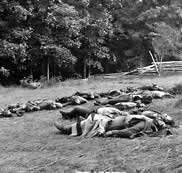
Captain DeRosset of Wilmington Left on the Battlefield to Die:
Capt. Armand L. DeRosset’s Fayetteville Arsenal Battalion, about 179 strong, held that portion of the
second line to the left of the Fayetteville-Raleigh Road. When the Federals attacked the second line
and drive the Arsenal Battalion from its initial position, the situation grew desperate. DeRosset knew
that his line could not hold for long, and he also knew that General Elliot was too far away to provide
quick guidance in this emergency, so he turned to the commander of Rhett’s Brigade, Col. William Butler,
for orders. Butler was reluctant to give orders to units not under his command and replied,
“I have no orders to give you.”
DeRosset then turned to the commander of the unit to his right, the 22nd Georgia Battalion, and
recommended that both units counterattack and drive the Yankees back. The commander of the
22nd Georgia Battalion concurred. While he was barking out orders for the counterattack, DeRosset
took a bullet that passed through both lungs. He was too severely wounded to be moved,
and was left on the battlefield to die.”
(No Such Army Since the Days of Julius Caesar, page 111)
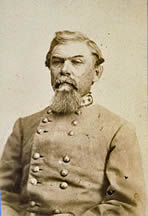
General Hardee's South Carolinians at Averasboro
“On through Fayetteville, across the Cape Fear River and up toward Averasboro went General [Joseph E.]
Johnston’s little army of hungry, ragged, men. Only a few days before an order had been issued that none would
be excused from duty merely because he had no shoes! And this was March, and it was cold and it rained –
Lord, it rained all the time.
So they slogged through the mud and the mire and ate parched corn, picked pork, roots, grub worms –
anything they could chew and swallow. It was at this time that Johnston’s chief surgeon stated he didn’t believe
there was a sound set of guts in the entire Confederate army. The route of Johnston’s retreat could be followed
by following the trail of dysentery-ridden soldiers left in houses along the way.
These, then, were the 6,000 men of General [William J.] Hardee’s Corps, composed principally of
South Carolinians, who placed themselves across the 3-1/2 mile stretch of land between the Cape Fear
and Black Rivers – 4 miles south of Averasboro. Their job? Lick the Yankees!
In the misty light of that rain-driven dawn of March 16, 1865, the battle began at the Gypsy Pine just
over the line in Cumberland County. The pine was a famous spot along the old stage road from Raleigh
to Fayetteville. Tradition has it that when the firing began, the form of a gypsy girl, standing on the crown
of the pine, was outlined against the murky sky. In her hand she held a wand which she waved from time
to time. As she waved it, cannon and rifle balls would fall harmlessly to the ground.
The battle line moved on and the gypsy girl disappeared. But as night fell she was back again, her wand
exchanged for a fife. Over the bodies of the stiffened dead she piped a mournful lament, stepped off into
the wind and vanished in the darkness.
Over in Black River Swamp the Confederates had charged the Yankee positions…intended to turn
the Federal right and neatly cul-de-sac the whole Yankee Army against the Cape Fear and destroy it.
Six thousand against twenty thousand! The charge failed.”
(They Passed This Way, Malcolm Fowler, pp. 96-97)
"Where Home Used To Be"
“Janie Smith, age 18 [of Averasboro], with eight brothers in the Confederate armies, writes to her
friend Janie Robeson of Bladen County. The letter is written on fly leaves of books, bits of wall paper,
any paper that could be used. It is plaintively headed: “Where Home Used To Be – April 12, 1865.
“…at daylight on the 16th [of March] the firing was terrific. The infirmary was here and – oh! It makes
me shudder when I think of the awful sights I witnessed that morning. Ambulance after ambulance
drove up with our wounded…the house, every barn and outhouse were full, and under every shed and
tree the tables were carried for amputating the limbs.
I just felt like my heart would break when I see our brave men rushing into battle and then coming
back so mangled….The blood stood in puddles in the grove; the groans of the dying and the shrieks
of those undergoing amputation was horrible. I can never forget it. (Note: the Confederate doctors
were almost entirely without anesthetics. They used brandy on the amputation cases.)
It was about nine in the morning when the courier came with orders for us to leave. Then was my trial,
leaving our poor sick and suffering soldiers when I could have been relieving them some. As we passed
the wounded going into the woods, they would beseech us:
“Ladies, don’t leave your home. We won’t let the enemy fire on you.”
(They Passed This Way, Malcolm Fowler, pp. 97-98),
Hoke’s Men and Boys at Bentonville:
“In this final carnage [General Joseph E.] Johnston had at his command some fifteen thousand available men,
while Sherman opposed him with an army seventy thousand strong, flushed with victory. On the morning
of March 20 it was reported that the Federal right wing had crossed over to unite with the left wing which
had been driven back and was coming up rapidly upon the left of [General Robert F.] Hoke’s division.
Hoke was directed to change front to the left. Here light entrenchments, made out of dead trees, were thrown
up, and earth was dug with bayonets and filled in by the use of tin pans. From noon to sunset Sherman’s
army, now united, made repeated attacks upon Hoke’s division of six thousand men and boys, but were
uniformly driven back. The skirmish line of the brigade and the center were commanded
by [nineteen year-old] Major Walter Clark.
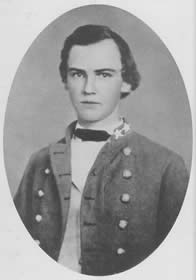
Walter M. Clark
The battle raged through March 20 and 21 [and] The Federals made repeated attempts to force the passage
of the bridge, but failed. No bolder movement was conceived during the war than this of General Johnston,
when he threw his handful of men on the overwhelming force in front of him, and when he confronted and
baffled his foes, holding a weak line for three days against nearly five times his number. For the last two
days of this fight, he held his position only to secure the removal of his wounded.
The Junior Reserves lost a number of officers and boys in this battle. It is reported that Major Clark time and
again mounted the improvised breastworks and cheered his gallant men on until his left flank had been completely
turned, and General Hoke commanded him to retreat. General Hoke wrote later of the Junior Reserves:
“The question of the courage of the Junior Reserves was well established by themselves in the battle below
Kinston and at the battle of Bentonville. Their conduct…was equal to that of the old soldiers who had
passed through four years of war. I returned through Raleigh, where many passed by their homes, and
scarcely one of them left their ranks to bid farewell to their friends, though they knew not where they
were going nor what dangers they would encounter.”
(Walter Clark, Fighting Judge, pp. 20-21)
Refusing Southern Care
“As we returned to our lines [as Johnston slowly disengaged with the enemy army at Bentonville], which we
did in a leisurely way and with little or no order, notwithstanding the enemy’s shells were singing a dirge in the
treetops overhead, I rode through [a swamp] with two men of my regiment. In going through my horse shied,
and, looking around, I saw a Federal lieutenant of infantry leaning against a tree, badly wounded,
with bloody water all around.
I checked my horse, returned to him, and offered to place him on my horse and carry him to
our division hospital, where he would be immediately cared for.
His answer was: “You go to h[ell], you d[amned] Rebel. I had rather die than have your polluted hands
touch me.” [H]e grew worse and worse and cursed the South and all Confederate soldiers. So we left him
to his fate. He was about twenty-two years of age, well dressed and very handsome.”
J.A. Jones, Fifty-first Alabama Cavalry, Hagan’s Brigade, Army of Tennessee.
(Moore’s Historical Guide to the Battle of Bentonville, Mark A. Moore, pg. 69)
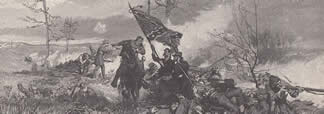
“The history of this battle must always be interesting to the student of our war –
showing how the Southerners fought when under the most adverse circumstances and
when the Cause was almost entirely lost . . . Every State in the South and almost the
entire North was represented on the bloody field of Bentonville. The gallant [General] Kirkland
and his surviving followers will always feel proud of the record they made there.”
Charles G. Elliott of Kirkland’s Brigade.
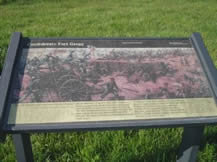
Two Hundred-Fifty North Carolinians Against Twenty-Five Thousand Invaders:
The Battle at Fort Gregg, April 2, 1865:
“The Federal infantry soon came into sight. One Mississippian later wrote: “Ah, what a contrast, what
a soul-sickening spectacle to behold. 25,000 men, flushed with recent victory, to be hurled against 250…
half-starved heroes, whose hearts of steel qualled not even at such fearful odds.”
“About ten o’clock the enemy commenced charging with four or five lines,” Lieutenant [Dallas M.] Rigler
[of Mecklenburg county] would write a few years after the war. “We did not fire until they were within
forty yards, and then gave them one volley; they wavered, and then the first line gave way; the second
came forward, and came within thirty yards of the fort. We yelled and fired – they stood a few seconds
and then broke. The third retreated also, but the fourth and fifth came to the ditch around the fort.
While this fighting was in the front, one line came in the rear and almost got inside the fort through the door.
About twenty men charged them, drove them back. About eleven o’clock they scaled the walls of the fort,
and for several minutes we had a hand to hand fight. We used the bayonet, and killed almost all of
them that came on top.”
Private [Angelum M.] Garrison [of Mecklenburg county] chronicled: “A man of Company D, of our
regiment, volunteered to shoot while three of us loaded, and we did the best that was possible. This soldier of
Company D took good aim, and I think he must have killed or wounded scores of the enemy.”
Twenty-year old Lieutenant Rigler would conclude his story of the defense of the fort:
“About half-past eleven they attempted to scale the walls again. We met them with the bayonets,
and for several minutes it was the most desperate struggle I ever witnessed; but it did not last long.
Soon they were all killed or knocked back, and then a deafening shout [arose] from our boys. [But]
by this time the ammunition was almost out, and our men threw bats and rocks at them in the ditch.
No ammunition would we get, and after a short struggle, they took the fort…”
General [Cadmus M.] Wilcox would add this, viewing things from outside the fort while in the
Confederate lines: “As they [Federals] appeared at this point [Fort Gregg], they were either shot
or thrust off with the bayonet….Again and again this was done. At length numbers prevailed, and
the parapet of the little work was thickly covered with men, six [Northern regimental] flags seen
on it at one time; and from this dense mass a close, and of necessity destructive fire, was poured
down upon the devoted band within.”
(The Thirty-seventh North Carolina Troops, pp. 228-229)
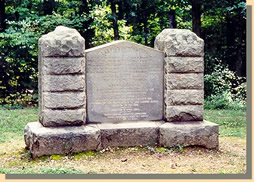
Appomattox, Attempting the Impossible Again:
“On Saturday, April 8, the weary and hungry men continued their march westward. “No enemy appeared,”
wrote [General Bryan] Grimes in his report of the campaign, “and we marched undisturbed all day.” The
sun bathed the Virginia countryside in warmth and light, and the spirits of the men improved somewhat, even
if the strategic position remained grim. It was obvious to everyone that Federal infantry was closely pursuing
them while strong legions of cavalry were riding west and south on a parallel course to get ahead of the Army
of Northern Virginia. If the army was cut off and unable to turn south, a junction with Joe Johnston’s
army would be impossible.
“Up to this time, since the evacuation of Petersburg,” Grimes explained, “we had marched all day and
night, continually followed and harassed by the enemy.” As a soldier in Grime’s Division recalled
the experience, “we just marched on, the ranks growing thinner and thinner, as the men would
fall out exhausted.” Following in the rear of [General John B.] Gordon’s Second Corps, Grimes
camped his men a couple miles behind near a small stream.
Their slumber was almost immediately disturbed when artillery fire opened in the distance about 9PM.
Grimes roused his men and ordered them to move out once more. The march consumed both their
strength and the night hours. Before daylight the division was still fitfully moving forward through the
quiet streets of Appomattox Court house. Just on the far side of the village, recalled Grimes, “I found
the enemy in my front.” The sun on Palm Sunday, April 9, was just beginning to emerge over the
horizon when Grime’s rode forward to make his dispositions.
Grime’s directed the remnants of [General] Bushrod Johnson’s Division to attack the Federals
on their left flank, while his own skirmishers charged their center. The line would be advancing against
a fresh stand of earthworks and a battery of artillery. “I then gave the signal to advance,” recalled Grimes,
at the same time [General] Fitz Lee charged…Grimes’ infantry quickly captured the line of breastworks
“without much loss,” together with several pieces of artillery. His division was moved forward to support
the skirmish line…”driving the enemy in confusion for three-quarters of a mile.”
Grime’s stopped the advance…[and] sent a message to Gordon that “the Lynchburg road was open
for the escape of the wagons,” and awaited orders. The directive he received was completely unexpected:
Grimes was to withdraw his command immediately.
“This I declined to do,” wrote Grimes, “supposing that General Gordon did not understand the
commanding position my troops occupied.” Gordon, however, “continued to send me order after
order to the same effect, which I still disregarded, being under the impression that he did not
comprehend our favorable location.” An exasperated Gordon sent another withdrawal order
accompanied this time with an order from General Lee, “to fall back.” A dejected and confused
Grimes now had no choice but to obey.
Withdrawing his men after his penetration of the Union lines, however, was a difficult undertaking and
required no little tactical finesse. When the Federals spied the movement, they “rushed out from
under cover with a cheer, when [Col. William R.] Cox’s Brigade, lying concealed at the brow of the hill,
rose and fired a volley into them, which drove them back into the woods; the brigade then followed
their retreating comrades in line of battle unmolested.”
Grimes’ men had just fired the Army of Northern Virginia’s last volley of the war.
[Grimes later] marched his men “beyond the creek at Appomattox Court House, stacked arms
amid the bitter tears of bronzed veterans, regretting the necessity of capitulation.” Appreciating
perhaps for the first time that the fighting was over, he guided his faithful horse Warren through the
lines in search of his old regiment, the 4th North Carolina, [men from Iredell, Rowan, Wayne, Beaufort,
Wilson and Davie counties]....My purpose, he later wrote, “was to shake the hand of each comrade
who had followed me through four years of suffering, toil, and privation, often worse than death, to
bid then a final, affectionate, farewell.”
He vividly recalled the remark of a particular private, “a cadaverous, ragged, bare-footed man [who]
grasped me by the hand, and, choking with sobs, said, “Good-bye General; God bless you; we will
go home, make three more crops, and try them again.” Grime’s called…[the 4th North Carolina]
to “attention” one last time and had them file past so he could grasp the hand of each man. “With
streaming eyes and faltering voice,” recalled Major [Edwin A.] Osborne, he said, “Go home, boys,
and act like men, as you have always done during the war.”
(Bryan Grimes of North Carolina, pp. 249-256)
"Appomattox: The Advance is Stopped"
“About 4AM the morning of the 9th [Palm Sunday] we mounted and were marched through the
village to about one-third of a mile west of the [Appomattox] Court House and formed in line facing
the southwest on the right of [General Bryan] Grimes’ Division next to [Colonel William R.] Cox’s Division.
Robert’s horsemen, consisting of the 4th North Carolina Cavalry and the 75th North Carolina (7th CS Cavalry),
took a position on the Confederate right.
W.H.F. Lee’s Division was ordered to advance after the Federal artillery opened on their position.
First Lt. E.J. Holt (75th NC) recounted that the Federal artillery “was a little to the left of our front and about
700 or 800 yards distant. The battery was in an open field and near to woodland on its left and rear, and
was very much lower than the position held by us.” Roberts ordered “sabers drawn” and charge.” Holt continues,
“when we got within 200 yards of them they began to run. Some ran into the woods, some took shelter under
the gun carriage and all quit firing.” Robert’s men captured about 50 prisoners and the Union ordnance, which
consisted of four Napoleons. This is reported to be the last capture of arms at Appomattox.
After the capture the Tarheels returned to the point of their original line to reform their command. Shortly before
9AM they skirmished with a small [Northern] force….but fell back due to terrain and the superior Spencer
rifles wielded by the Federals.
The 4th North Carolina Cavalry’s 2nd Lt. William P. Shaw [of Hertford county] eloquently
summarized the end in his 1904 recollection:
“The advance is stopped. The physical valor and human endurance can go no further. The last act in the
tragic drama is closed. The rattle of musketry and the roar of artillery cease. The curtain drops.
The Army of Northern Virginia has surrendered.”
(The 4th North Carolina Cavalry in the Civil War, Neil Hunter Raiford, McFarland & Co., 2003, pp. 87-88)
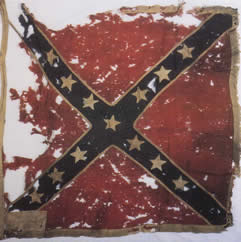
"Existing on Big Hominy":
“On the tenth of March [1865], less than a month after the burning of Columbia, [Northern] cavalry
overran Fayetteville, North Carolina, and the surrounding country. At Manchester, these troopers came upon
the estate of the aged Mr. Duncan Murchison. Here Miss Kate P. Goodridge and her sister were “refugeeing”
from Norfolk. The Goodridge family was originally from New England; but, like practically all New England settlers
in the South, they were heart and soul with the cause of the Confederacy, and the bore the privations with a heroism
no less than the native Southerners. Five of the Goodridge family had enlisted in the Confederate service.
As in the case of thousands of other private houses, the Murchison mansion was thoroughly ransacked;
but many of the family valuables had been hidden so successfully that some of the soldiers became
enraged at not securing greater booty; in spite of protests, they burst into the room of a young girl who was
in the last stages of typhoid fever.
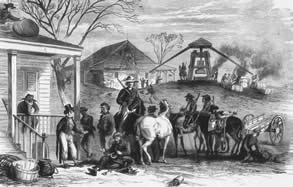
The child was taken from the bed in which she lay and died while the bed and room were being
searched for money and jewelry. An officer, whose name indicated foreign birth or extraction, was appealed
to; but his answer to the Goodridge ladies was: “Go ahead boys, do all the mischief you can.”
Although over seventy years old, Mr. Murchison, a kinsman of Sir Roderick Murchison, was threatened
with death; but Miss Phoebe Goodridge fell on her knees and begged for his life. Consequently, the soldiers
refrained from carrying out their threat, but dragged Mr. Murchison, half-clad, into the nearby swamps, where he
was compelled to stay until the raiders had gone away.
The troopers slashed the family portraits with their swords, broke up much of the furniture,
and poured molasses into the piano. Everything in the nature of food was destroyed. Cattle and poultry
were driven off or shot. All granaries of corn or wheat were torn open and the contents carried off or ruined.
Consequently, the members of the family were, like many of the women of Georgia and South Carolina,
compelled to live on scattered grains left by the cavalry horses, which they washed and made over
into what they called “big hominy.”
(The Women of the South in War Times, pp. 226-228)
Refugeeing in Robeson County:
“With great vividness I remember, also, how in March, 1865, after Sherman had burned Columbia
and left the South so poor “that a crow would have to carry its rations in order to exist,” General Francis P. Blair,
of Sherman’s army came with his corps, consisting of General Hickenlouper’s Brigade and other troops,
through Robeson County, where we were refugeeing. The corps that came immediately around our home consisted
of Germans of Hickenlouper’s Brigade, who could speak very little English, and German officers were in
command. These were hirelings of the United States Government, very much as the Hessians were hired
during the Revolutionary War.
It had been rumored that my father was a very wealthy man, and immediately these Hessians drew their
steel ramrods out of their muskets, and began to pierce the ground all around our home and other places on
the premises, to find what treasure they could unearth.
They found the silver my sister had buried under the steps. They also discovered a valued deposit in which
was my father’s diploma from Jefferson College, of the University of Pennsylvania. [The] bummers had gone
through our home and cut open the locked bureau drawers with axes and stolen every valuable they could
find…and officer, with three or four Germans…demanded that my mother give them the contents of her safe,
which contained milk, butter, and other food. Of course she had to comply!
They left us without food and penniless for nearly a week, after the troops continued their march to
Fayetteville and Wilmington and through to Bentonville. The army also induced to leave, and took with
them, all of our servants, former slaves that we had, leaving not one.
These bummers, as we called them, were very cruel and frightful in their acts. A certain lady living in the
neighborhood had money and jewels, which she had hidden in the mattress of her bed. Someone told them
about this and they went to her home and found her sick in bed. They asked for the money and she
denied having it. They pulled her out, raised up the mattress, found her valuables, and took them!
As a punishment, they knocked in the top of a hogshead of molasses, which they found in her barn,
and dipped her, head and all, into the barrel!”
(Memoirs of an Octogenarian, John D. Bellamy, pp. 23-25)
Smithfield Review of Splendid American Soldiers:
“After the battle of Bentonville, General [Joseph E.] Johnston retired his army to Smithfield, where
he remained confronting [the enemy] for three weeks. While here General Johnston held a review
6 April, at which many ladies and civilians of Raleigh, including Governor Vance and officers of the
State and Confederate Government were present. The army presented a fine appearance
and the men were in excellent spirits.
There were in this army remnants of commands who under Albert Sidney Johnston won the
first day’s battle of Shiloh, and nearly annihilated Grant’s army. Men who under Bragg, had
won the battles of Murfreesboro and Chickamauga, and under Johnston had confronted Sherman
from Dalton to Atlanta; the men who under Hood, had been in the disastrous battle of Franklin;
who had followed [Generals Nathan Bedford] Forrest and [Joe] Wheeler and [Wade] Hampton
and had successfully defended Fort Sumter for four years against the combined land and sea
forces of the United States, and the brigades of [General Robert F.] Hoke’s Division, who had
won endearing renown in the Army of Northern Virginia.
Here also were assembled those regiments of Junior Reserves, who under Colonels Hinsdale,
Anderson, Broadfoot and Walter Clark emulated the heroism of their veteran comrades, and
who on the battlefields of Kinston and Bentonville had shown they were of the same [mettle]
as their sires and deserving of imperishable record in the history of their country.
It was a splendid body of American soldiers; survivors of a hundred battlefields; and as they marched
proudly in review before their General, they were conscious of duty nobly done and nerved for any future
service that might be required of them in defence of their country.
General [Thomas L.] Clingman visited his brigade while in camp at Smithfield, and though on crutches,
asked of General Johnston the honor of commanding the rear guard. This was denied him, as he was
physically unable to perform such duty, and he addressed the Southern commander as follows:
“Sir, much has been said about dying in the last ditch. You have left with you here thirty
thousand of as brave men as the sun ever shone upon. Let us take our stand here and
fight the two armies of Grant and Sherman to the end, and thus show to the world how far
we can surpass the Thermopylae of the Greeks.”
(Histories of the Several Regiments and Battalions from North Carolina in the Great War 1861-65,
Walter Clark, editor, Volume IV, Nash Brothers, 1901, pp. 498-499)

The Last Cavalry Charge in North Carolina
In late April 1865, Ordnance Sgt. William Hezekiah Mitchell (Company F., 1st Tennessee Cavalry, “Maury Braves”)
was detailed to take a scouting party of three men to ascertain the movements of Sherman’s advancing army.
The command had not learned of Gen. Joseph E. Johnston’s capitulation to Sherman and went as ordered.
They had reached a creek about 3 miles from Chapel Hill and headed off in the direction it was supposed that
Northern troops were marching. A company of Northern cavalry approached and using a bluffing strategy,
the four Tennesseans raised a rebel yell and made a furious charge that sent them in retreat. In chasing the
bluecoats, the four came upon a home they had just plundered and the owner provided them with the
direction of Sherman’s movements.
Returning to their command to report this intelligence, they were ordered with their entire squadron to
ride to the creek and hold it against the Northern advance. Upon arrival at the ford, they found Northern
infantry already in force and a barrier erected across the creek. A volley from the enemy knocked down
Col. Baxter Smith’s horse, and the command fell back to Sugar Creek Church near Charlotte.
There they stacked arms on 2 May, and left for Tennessee after being paroled on 3 May 1865 –
thus ending nearly four years of war which began with their enlistments at Ashford Hall
in Maury County, Tennessee on 5 July, 1861.
Mitchell and his unit were paid Mexican 8 Reales out of the Confederate treasury
by Gen. Johnston, an image of which appears below.
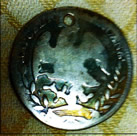
(Compiled from veterans recollections by Jill Garret, historian of Maury County, TN; courtesy Baker A. Mitchell)
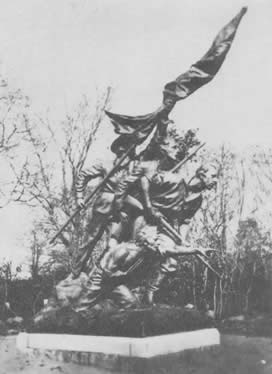
Sources and Bibliography:
The Old North State and the New, Vol. II, Archibald Henderson, Lewis Publishing, 1941
Confederate Military History, D.H. Hill, Jr., Blue & Gray Press, 1965
Zeb Vance, Champion of Personal Freedom, Bobbs-Merrill, 1965
The Civil War in North Carolina, John G. Barrett, UNC Press, 1963
Refugee Life in the Confederacy, Mary Elizabeth Massey, LSU Press, 1964
The Women of the South in War Times, Matthew Page Andrews, Norman, Remington Co., 1920
Carolina Cavalier, The Life and Mind of J.J. Pettigrew, Clyde Wilson, Chronicles Press, 2002
Journal of a Secesh Lady, Diary of Catherine Edmondston, Beth Crabtree, ed., 1979, NCDAH
Memoirs of an Octogenarian, John D. Bellamy, Observer Printing House, 1942
The Boy Colonel of the Confederacy, Henry King Burgwyn Jr., Archie K. Davis, UNC Press, 1985
Bethel to Sharpsburg, Daniel Harvey Hill, Vol. I, Edwards & Broughton, 1926
General A.P. Hill, James I. Robertson, Jr., Random House, 1987
Chronicles of the Cape Fear, James Sprunt, Broadfoot, 1916
No Such Army Since the Days of Julius Caesar, Smith and Sokolosky, Ironclad Publishing, 2005
Fort Caswell in War and Peace, Ethel Herring & Carolee Wiliams, Broadfoot, 1983
Lee’s Last Major-General, Bryan Grimes of North Carolina, T. Harrell Allen, Savas Publishing, 1999
The Battle of Monroe's Crossroads, Eric J. Wittenberg, Savas Publishing, 2006
Collett Leventhorpe, the English Confederate, Cole & Foley, McFarland & Co., 2007
The 4th North Carolina Cavalry in the Civil War, Neil Hunter Raiford, McFarland & Co., 2003
More Terrible Than Victory, North Carolina's Bloody Bethel Regiment, Craig S. Chapman, Brassey's, 1998
The Thirty-seventh North Carolina Troops, Michael C. Hardy, McFarland & Co., 2003
Last Rays of Departing Hope, the Wilmington Campaign, Chris E. Fonviell, Jr., Savas Publishing, 1997
Walter Clark, Fighting Judge, Aubrey Lee Brooks, UNC Press, 1944
The Making of a Confederate, Walter Lenoir's Civil War, William L. Barney, Oxford Press, 2009
They Passed This Way, Personal Narrative of Harnett County History, Malcom Fowler, Harnett Library, 1955
The Damned Red Flags of the Rebellion, Richard Rollins, Rank & File Publications, 1997
Dictionary of North Carolina Biography, William S. Powell, editor, UNC Press, 1986
Moore’s Historical Guide to the Battle of Bentonville, Mark A. Moore, Savas, 1997
The Debris of Battle, The Wounded of Gettysburg, Gerard A. Patterson, Stackpole Books, 1997
Copyright 2011, North Carolina War Between the States Sesquicentennial Commission